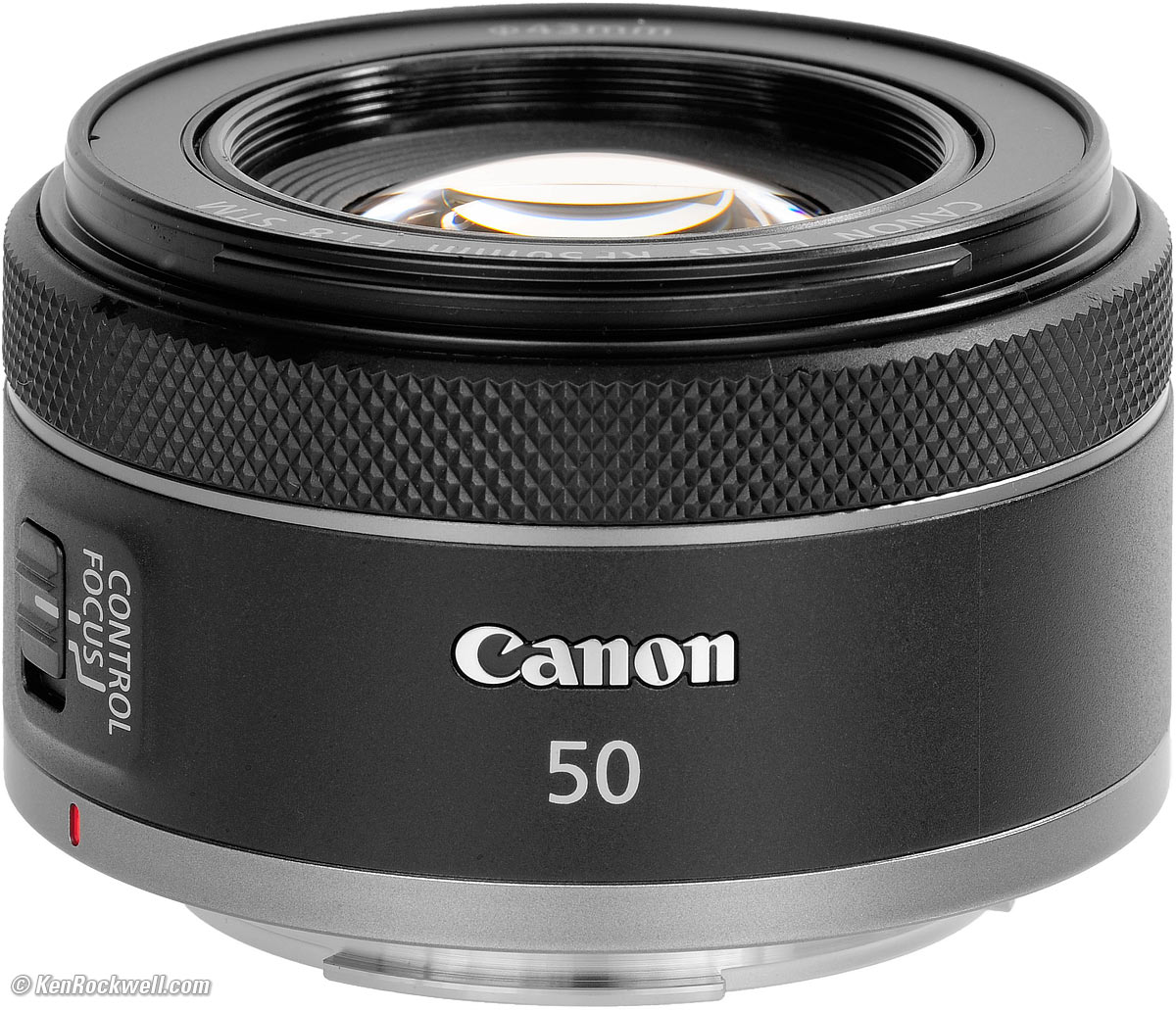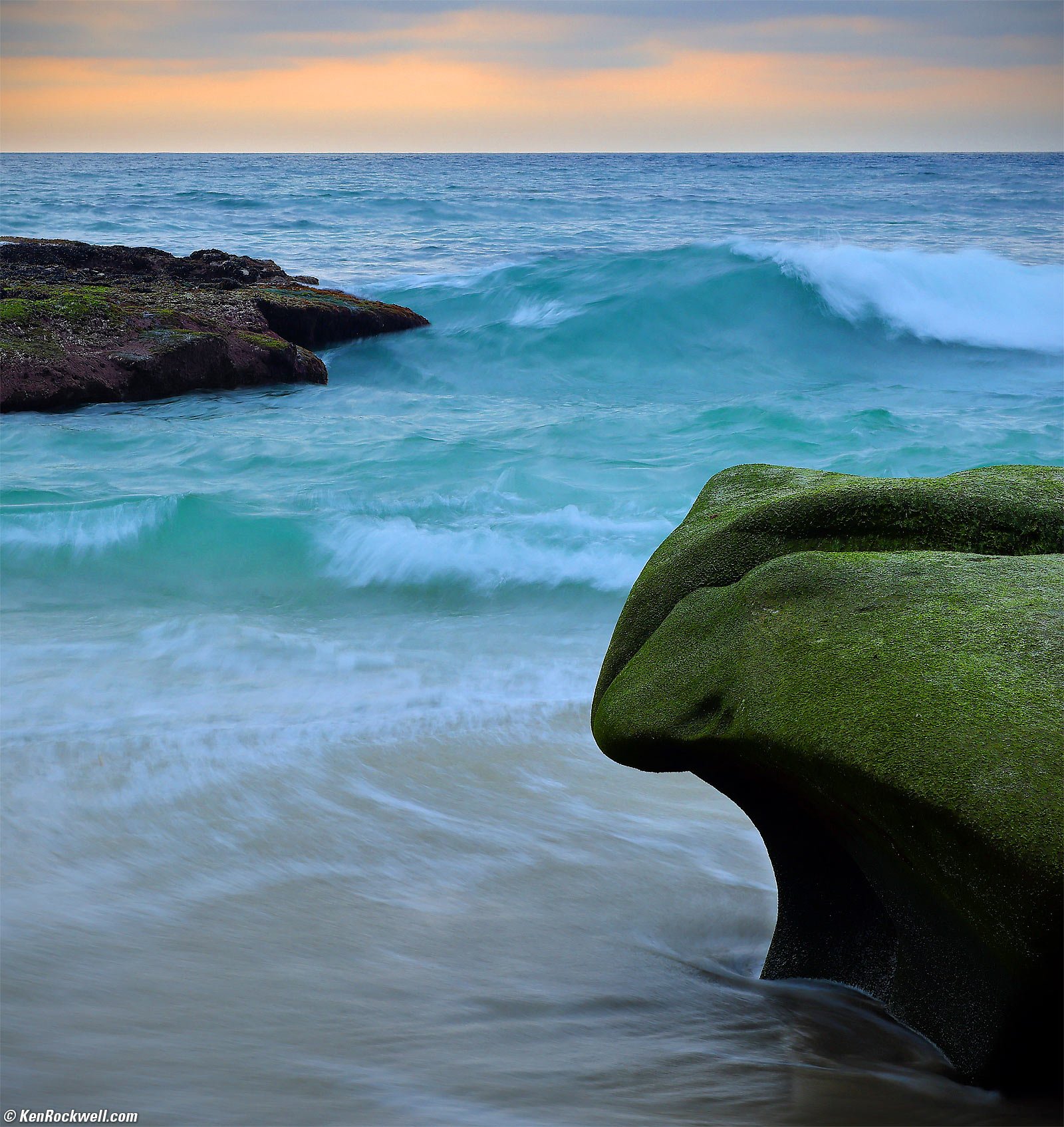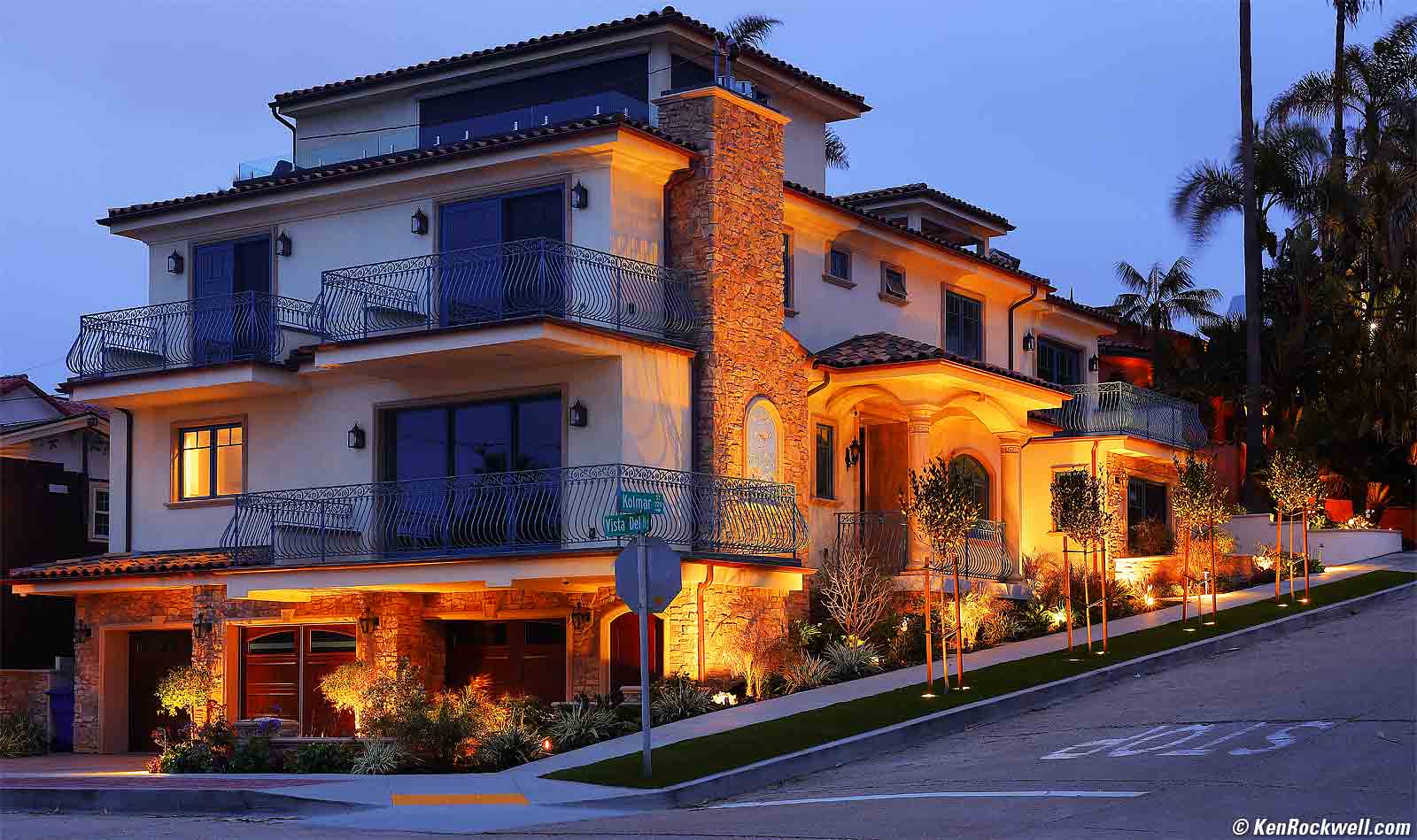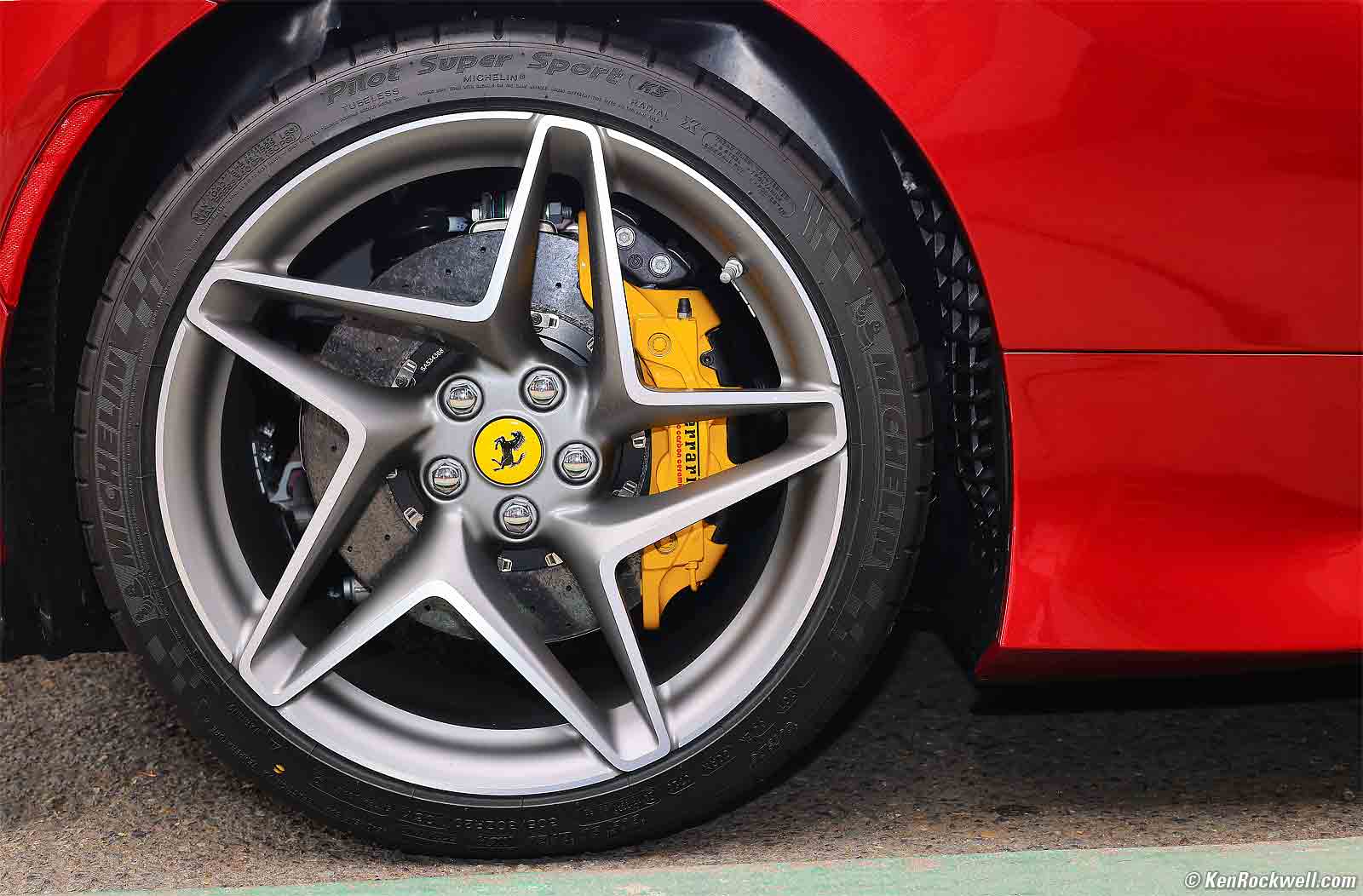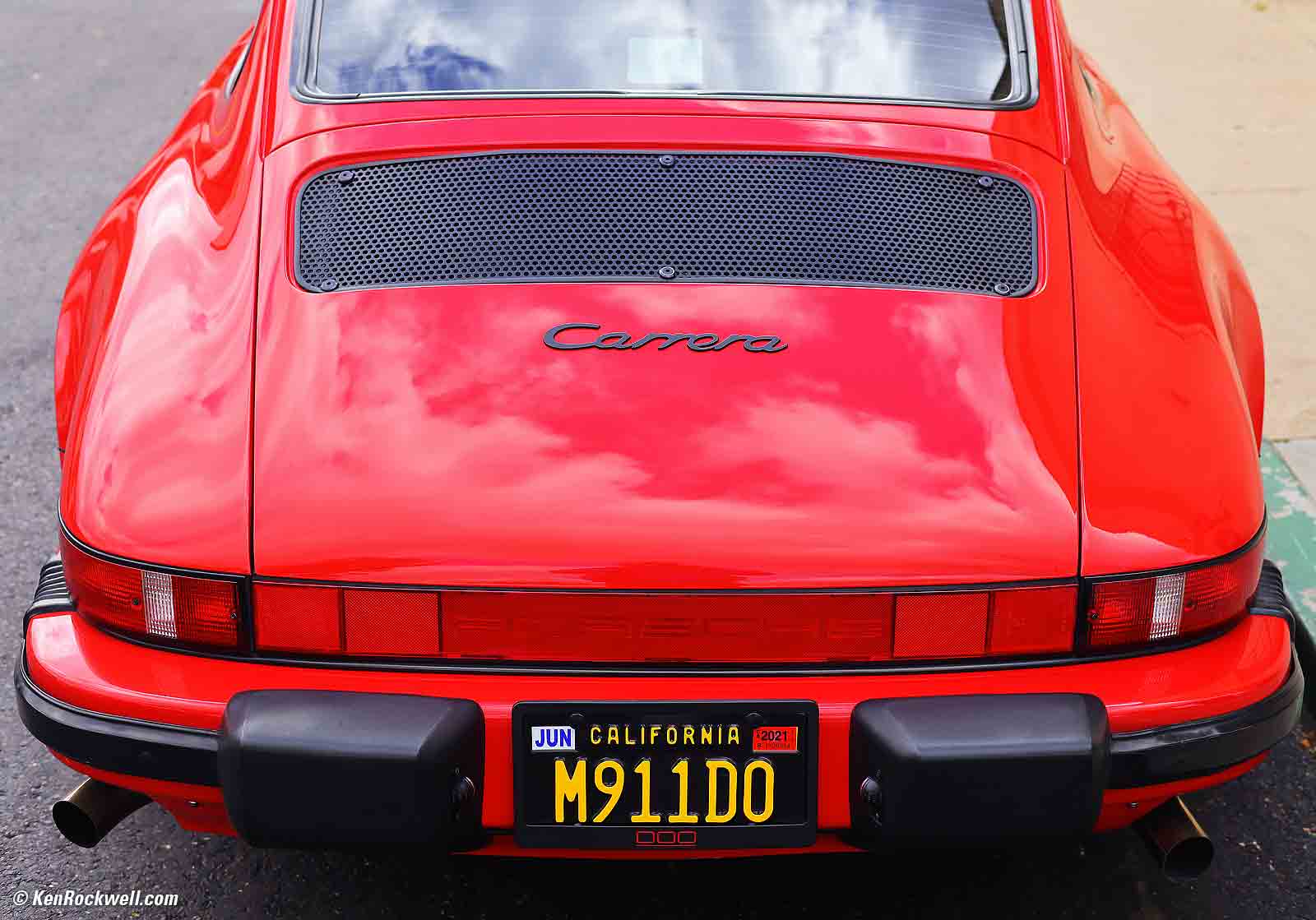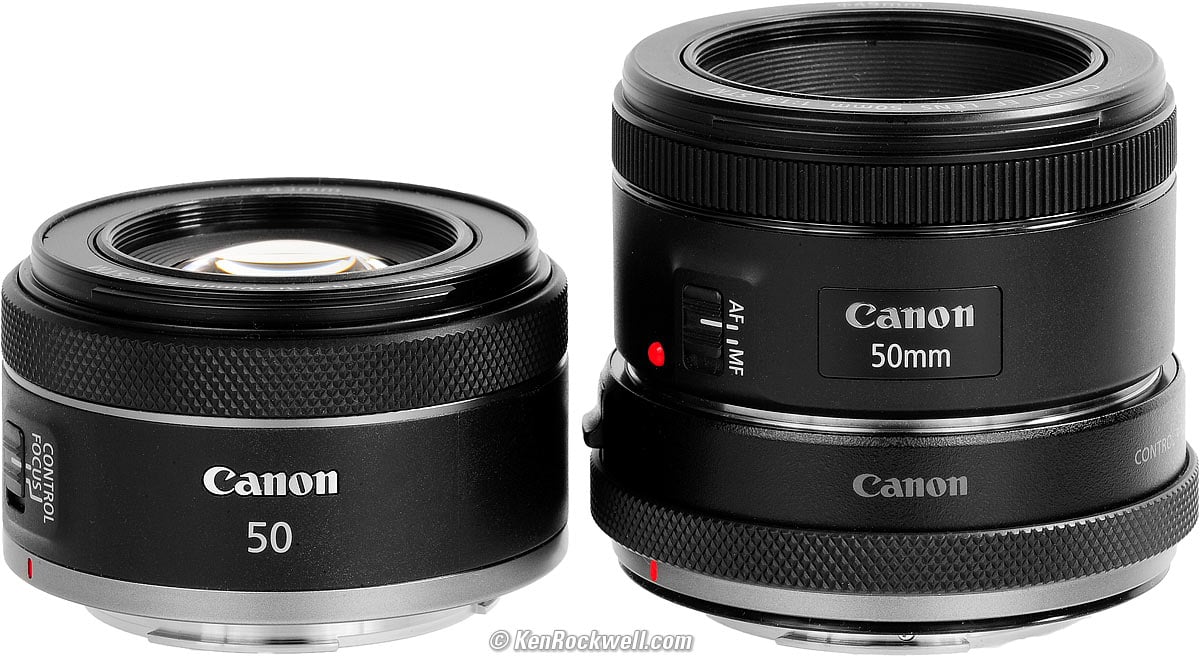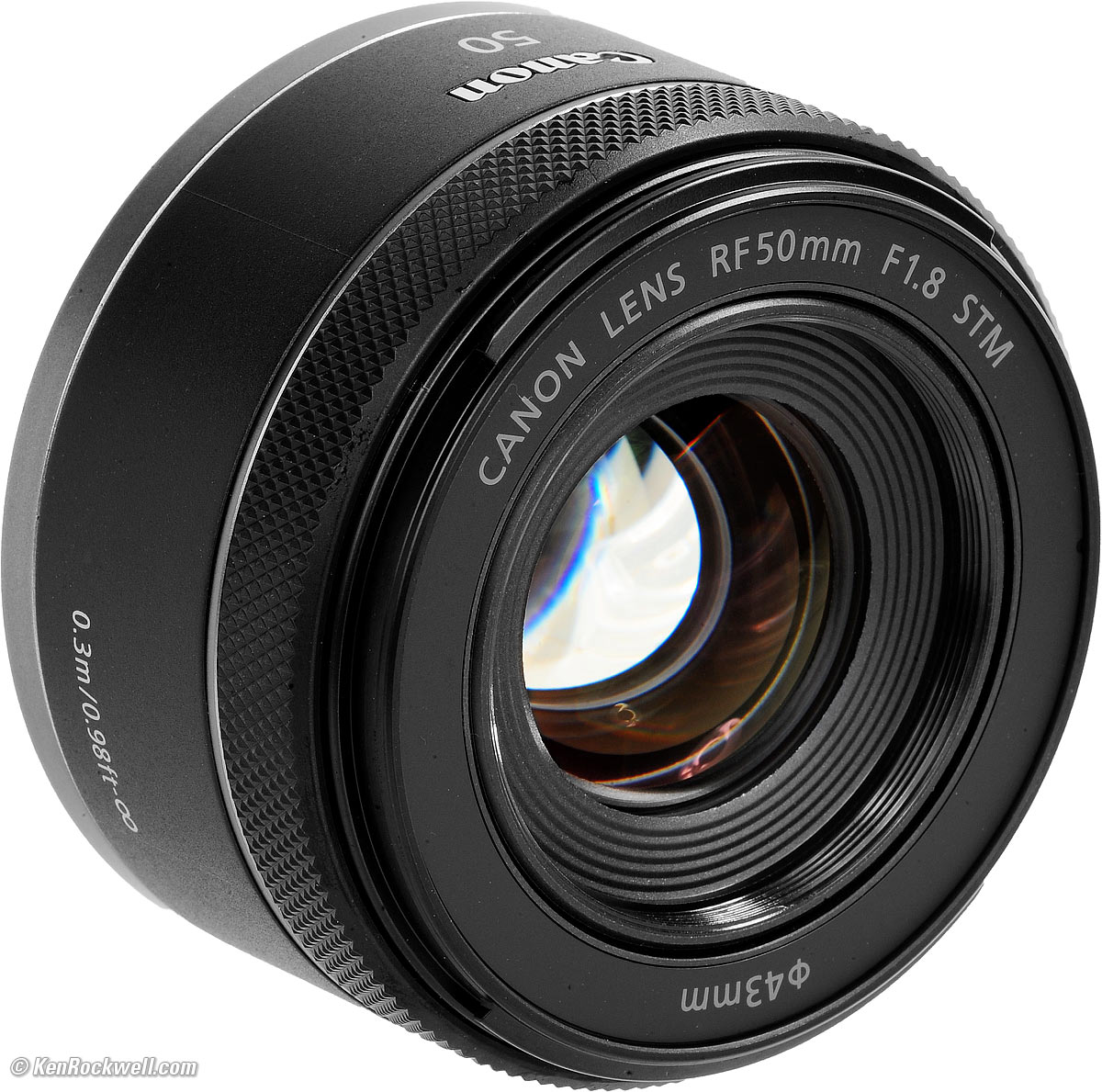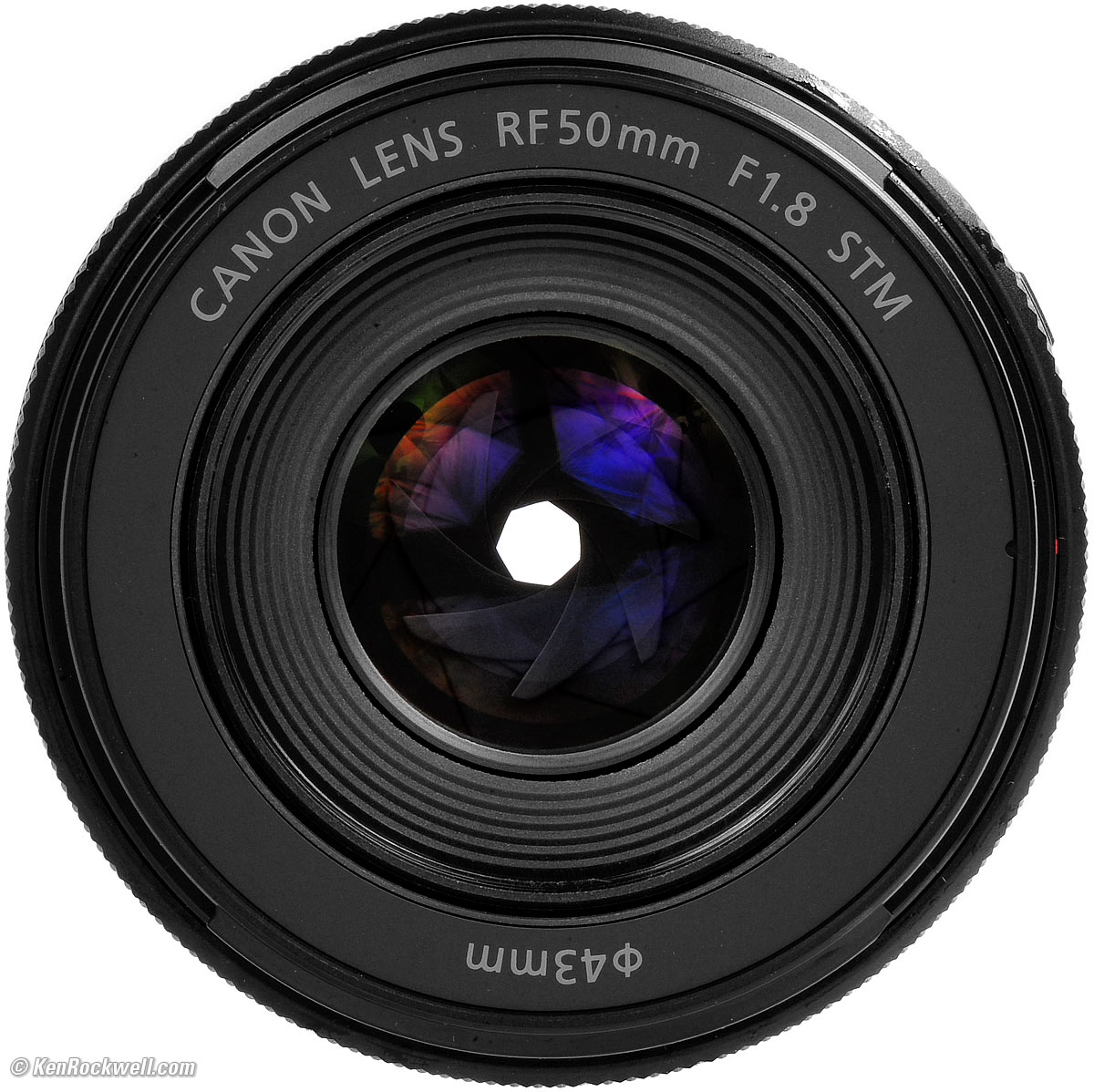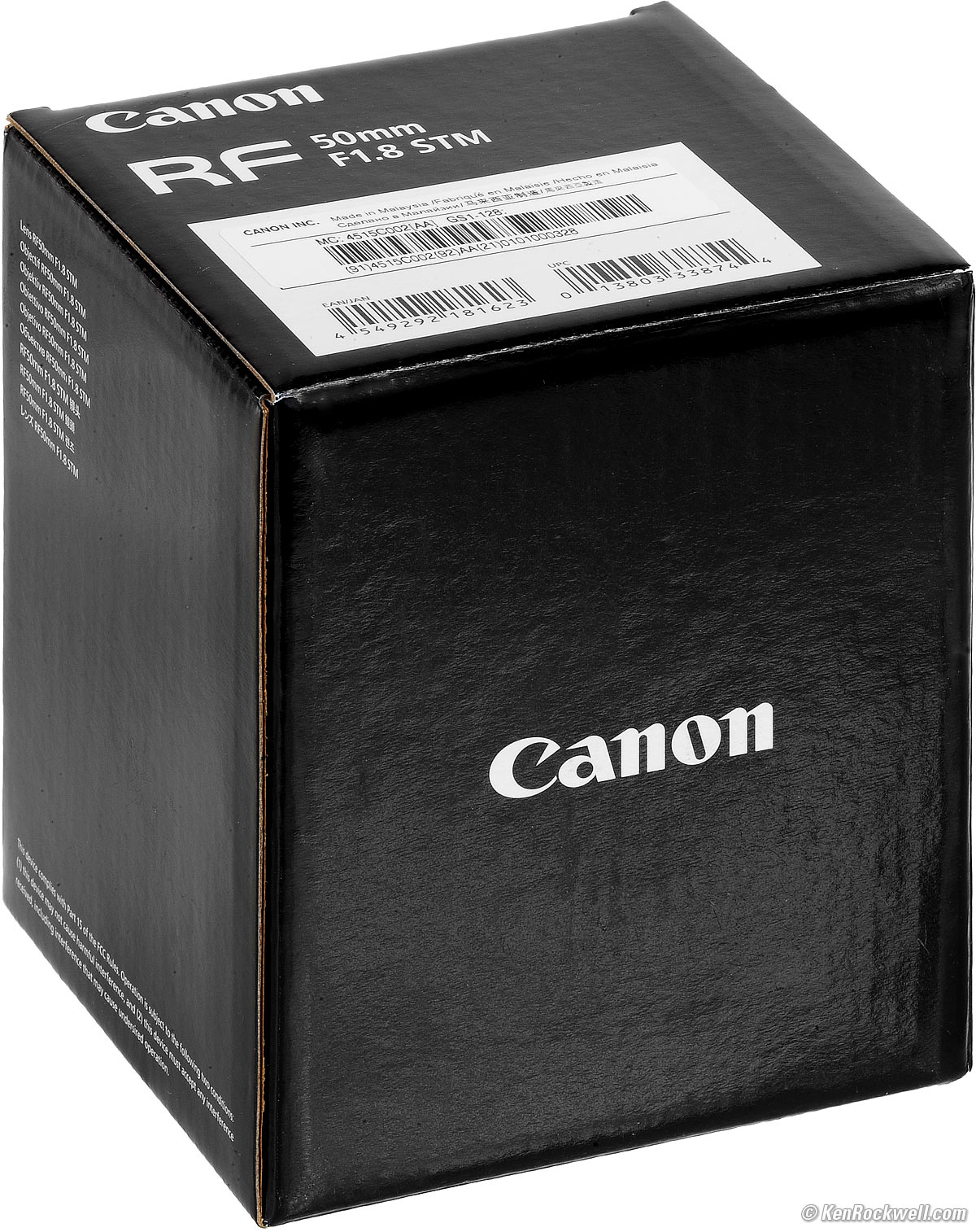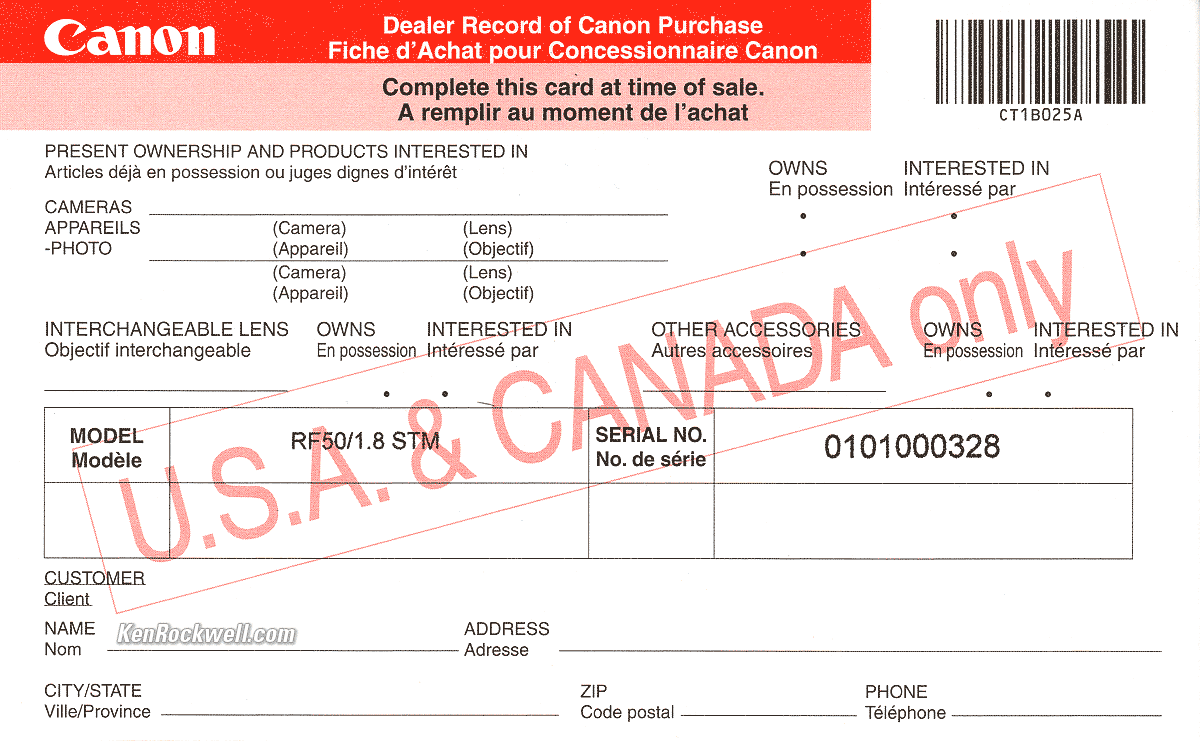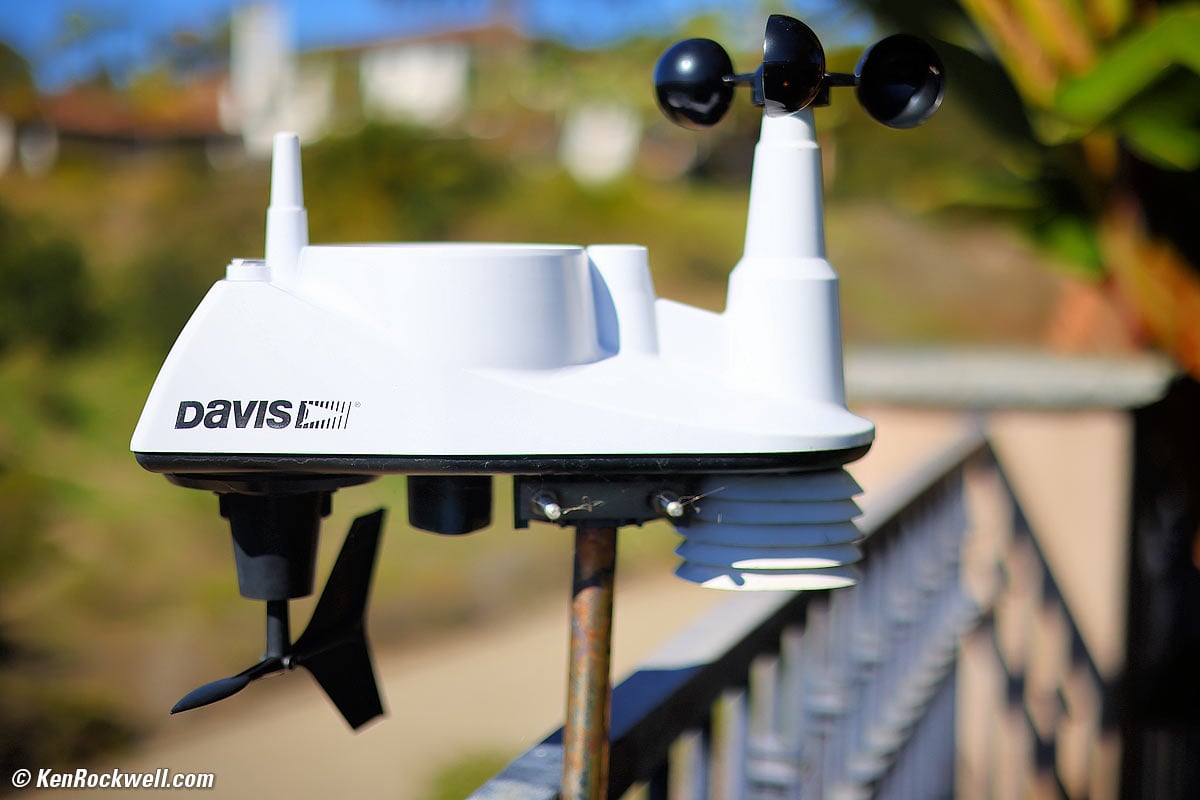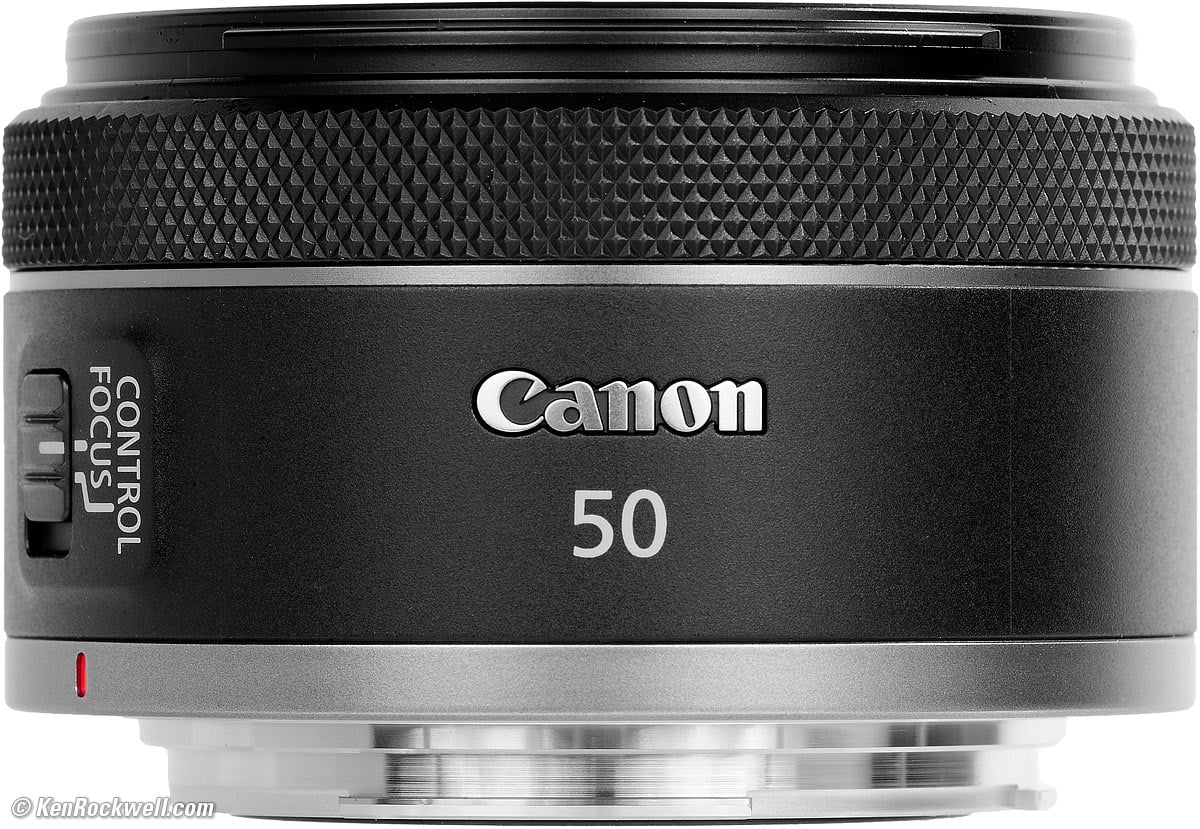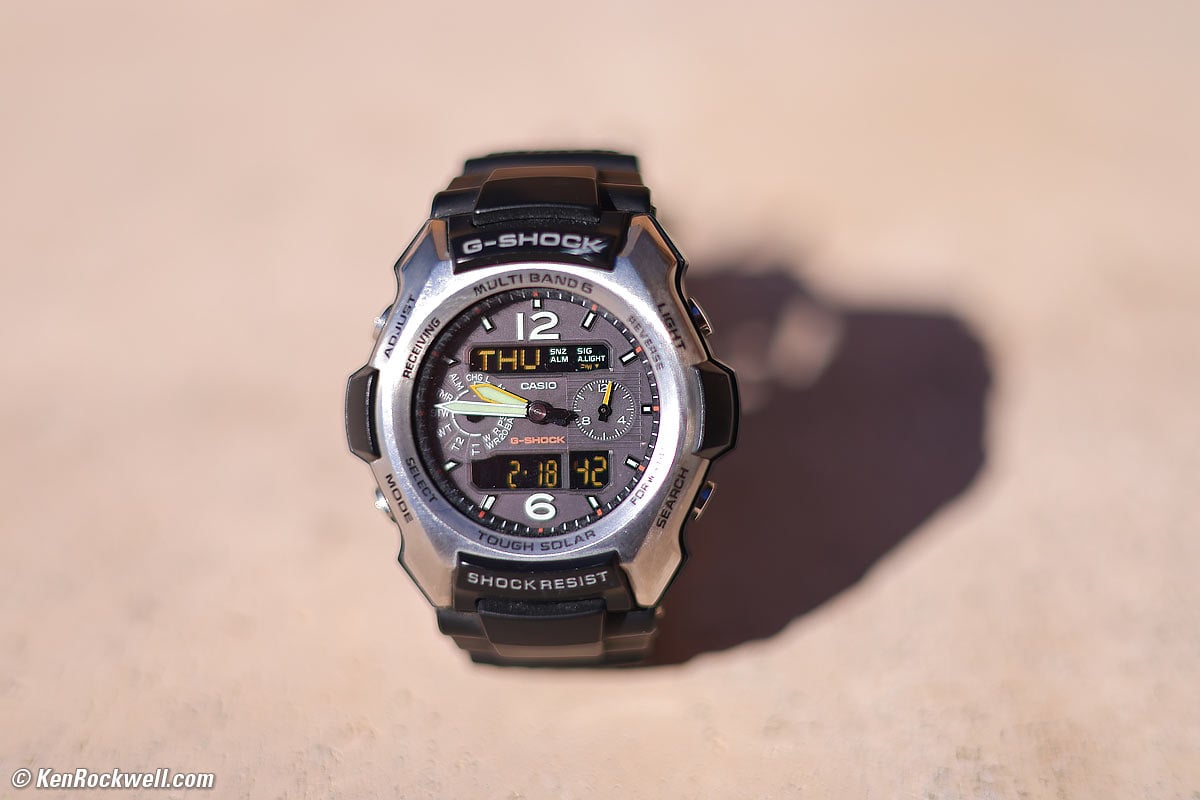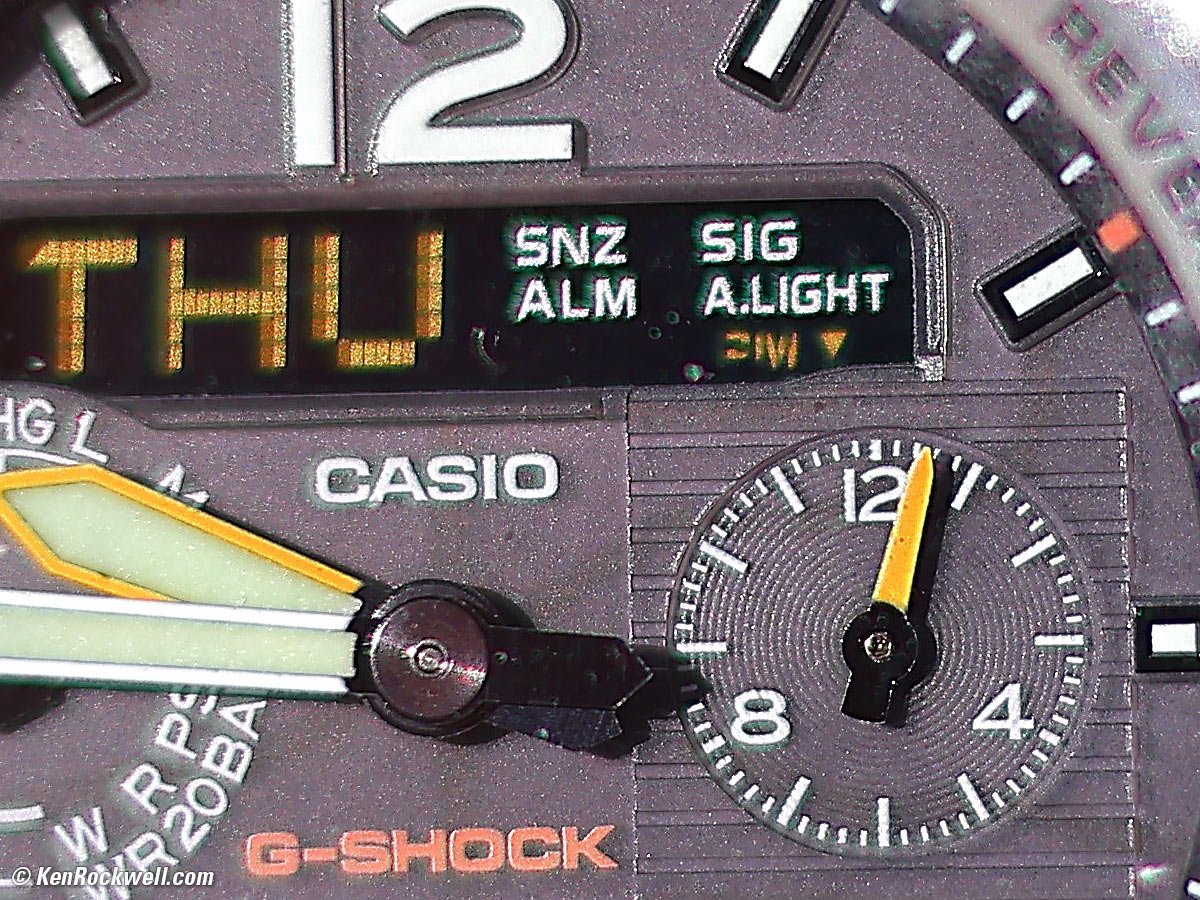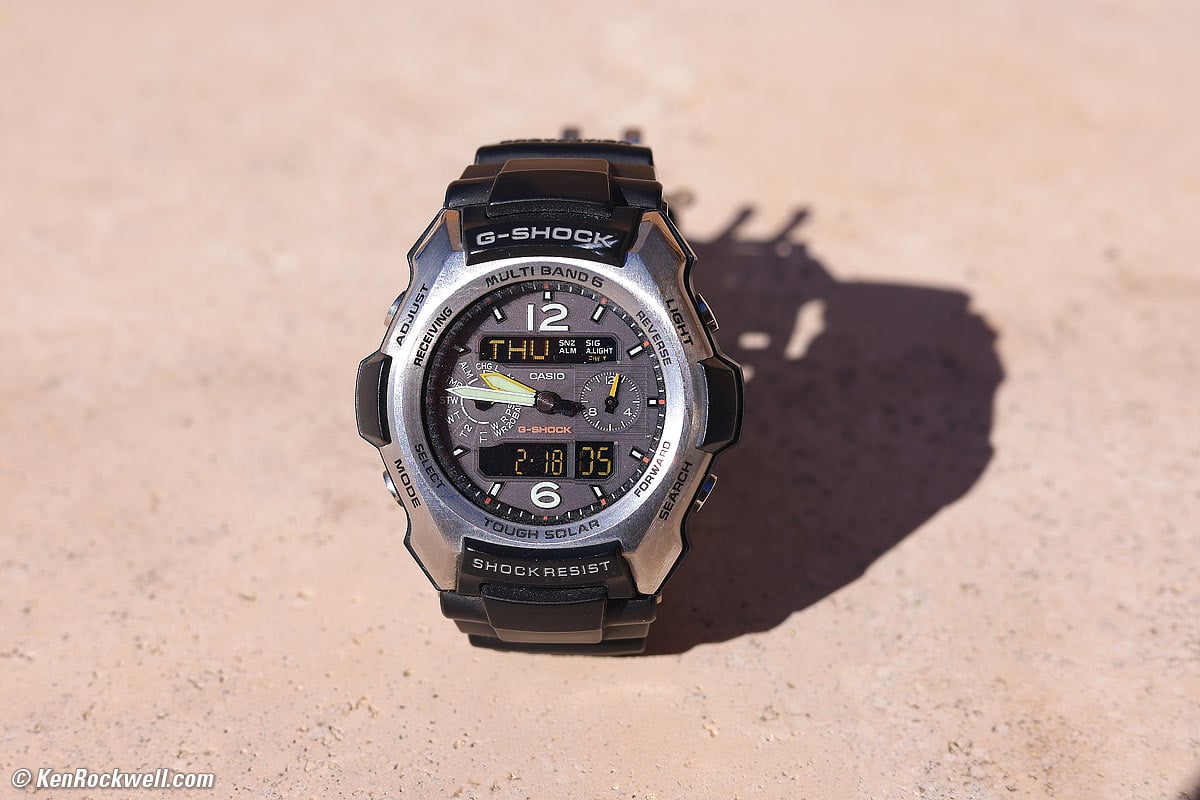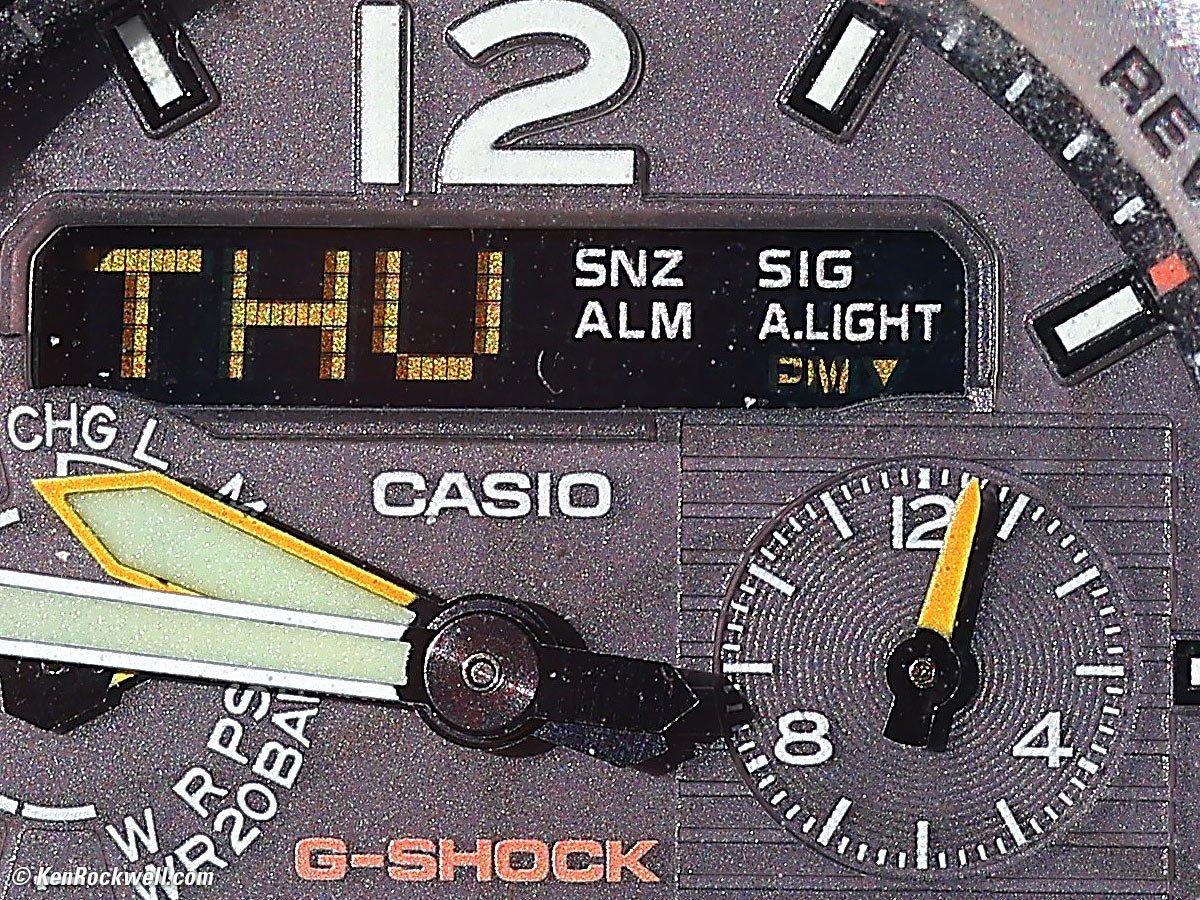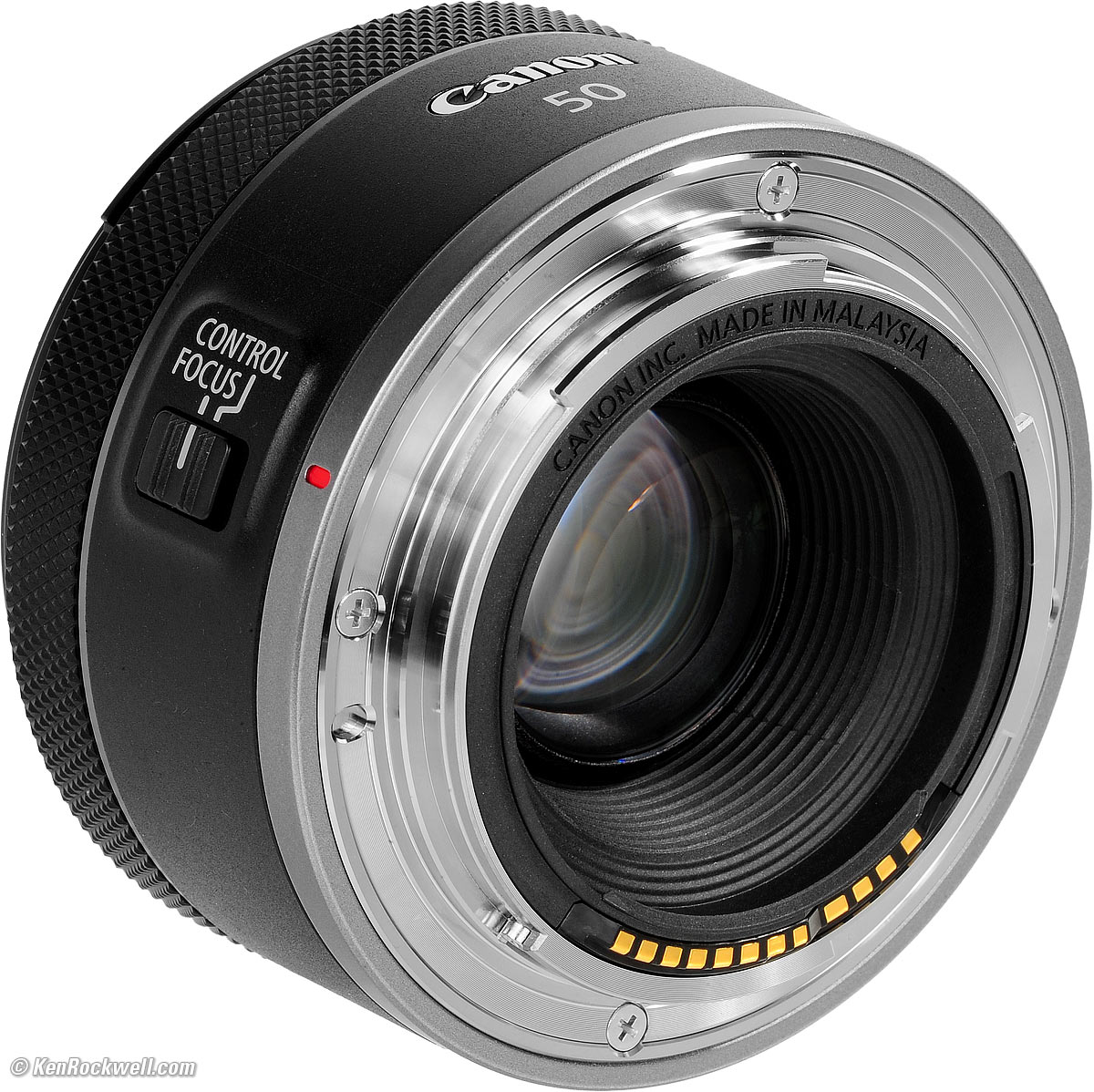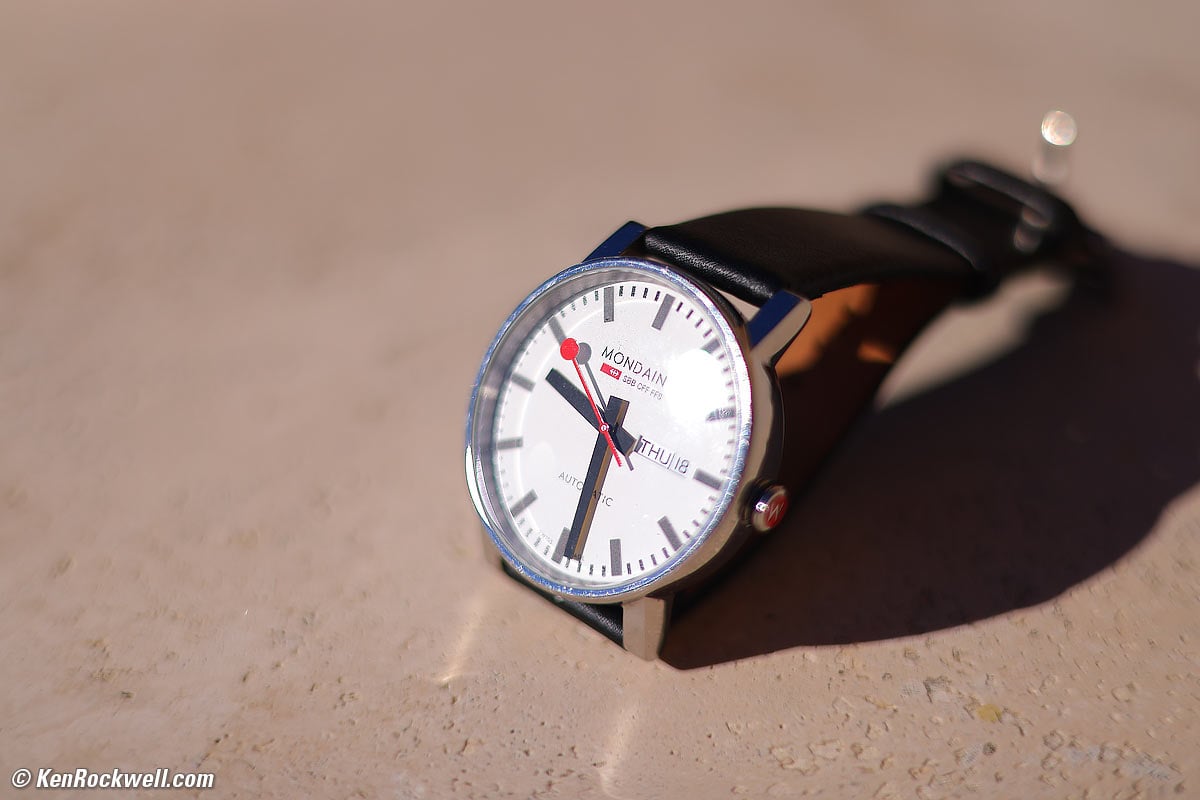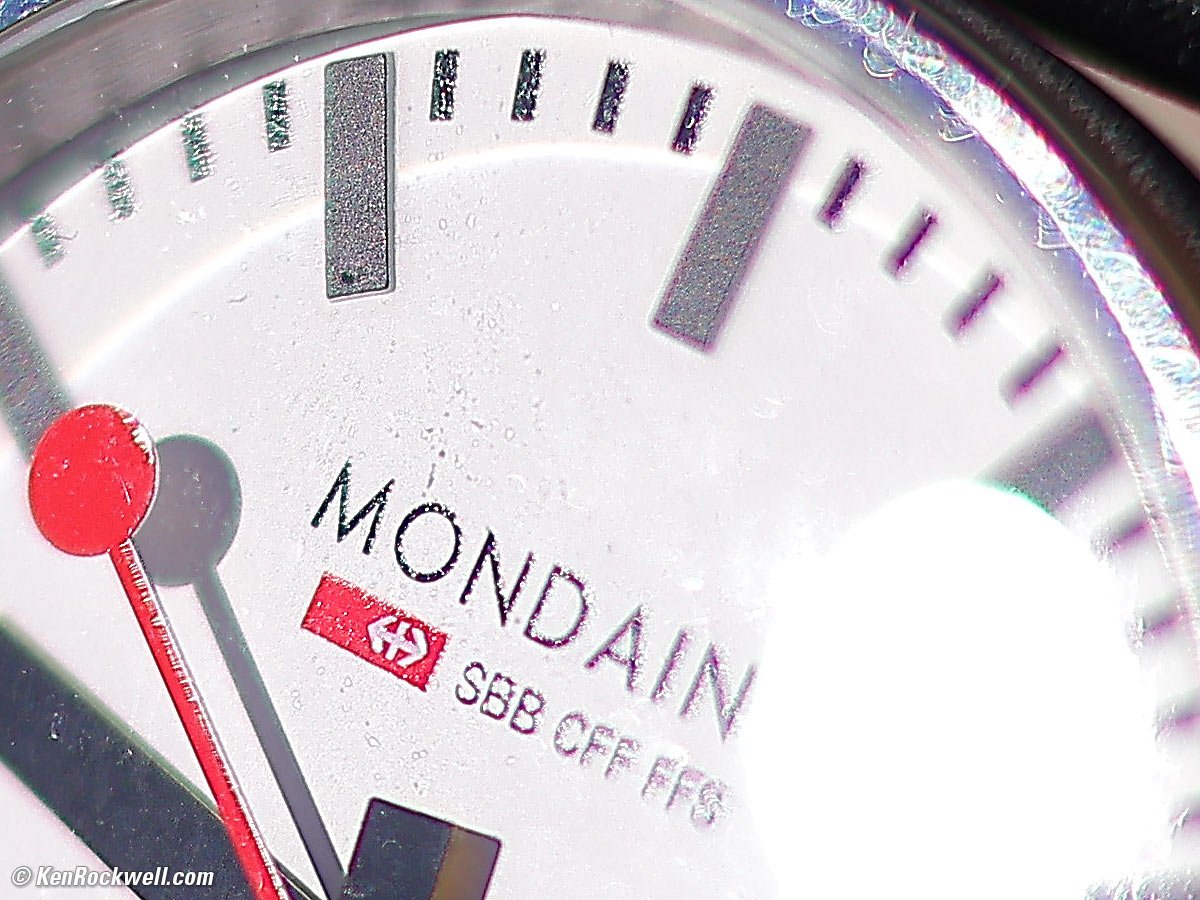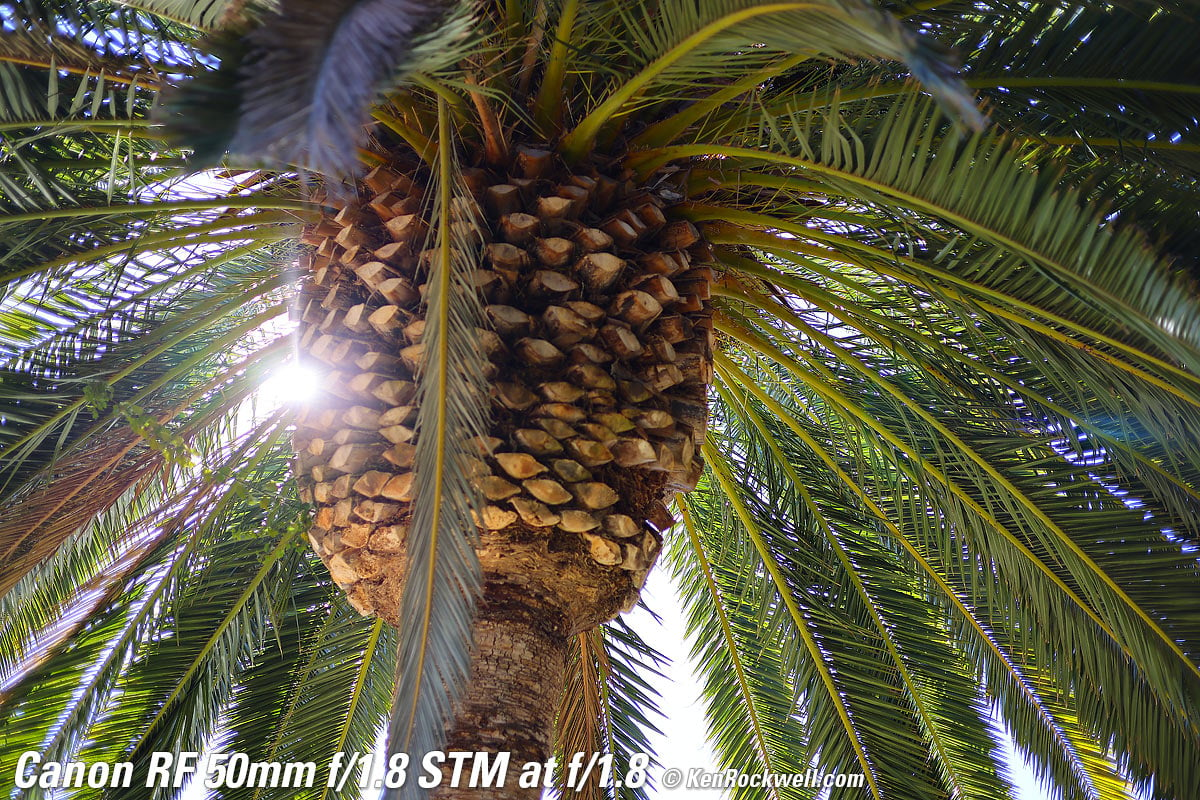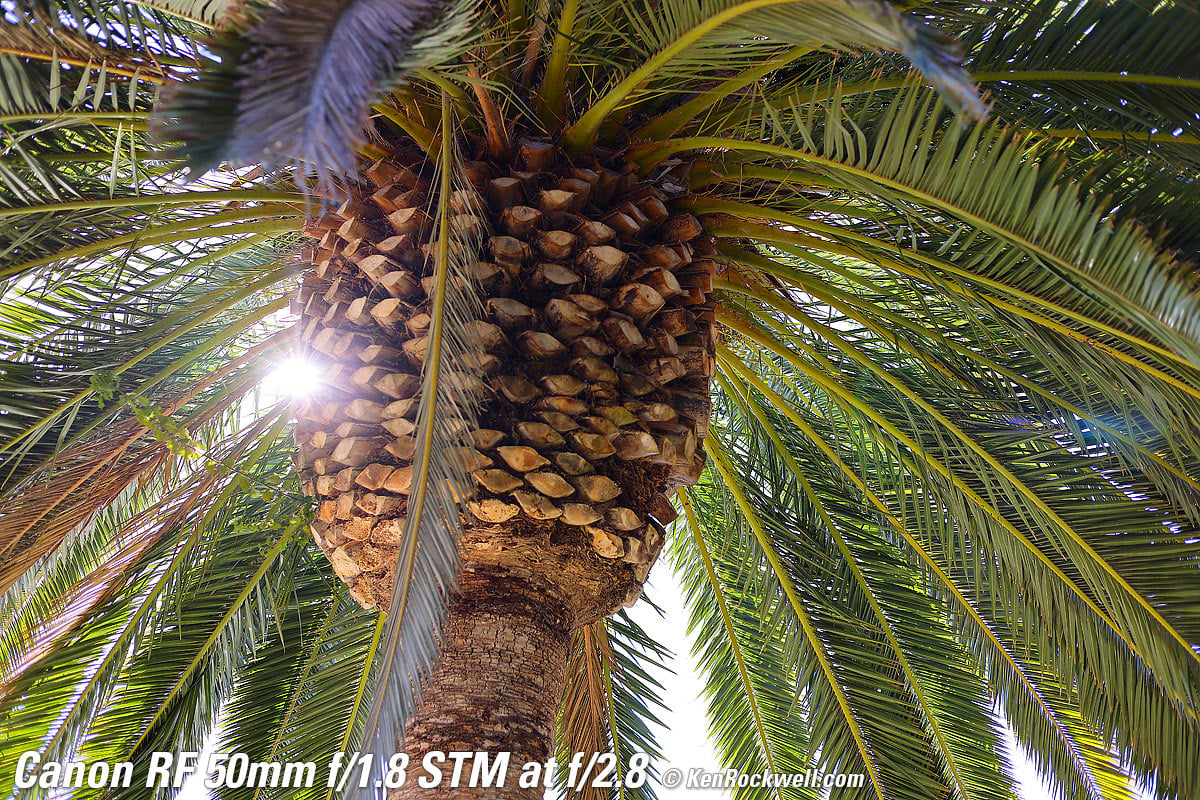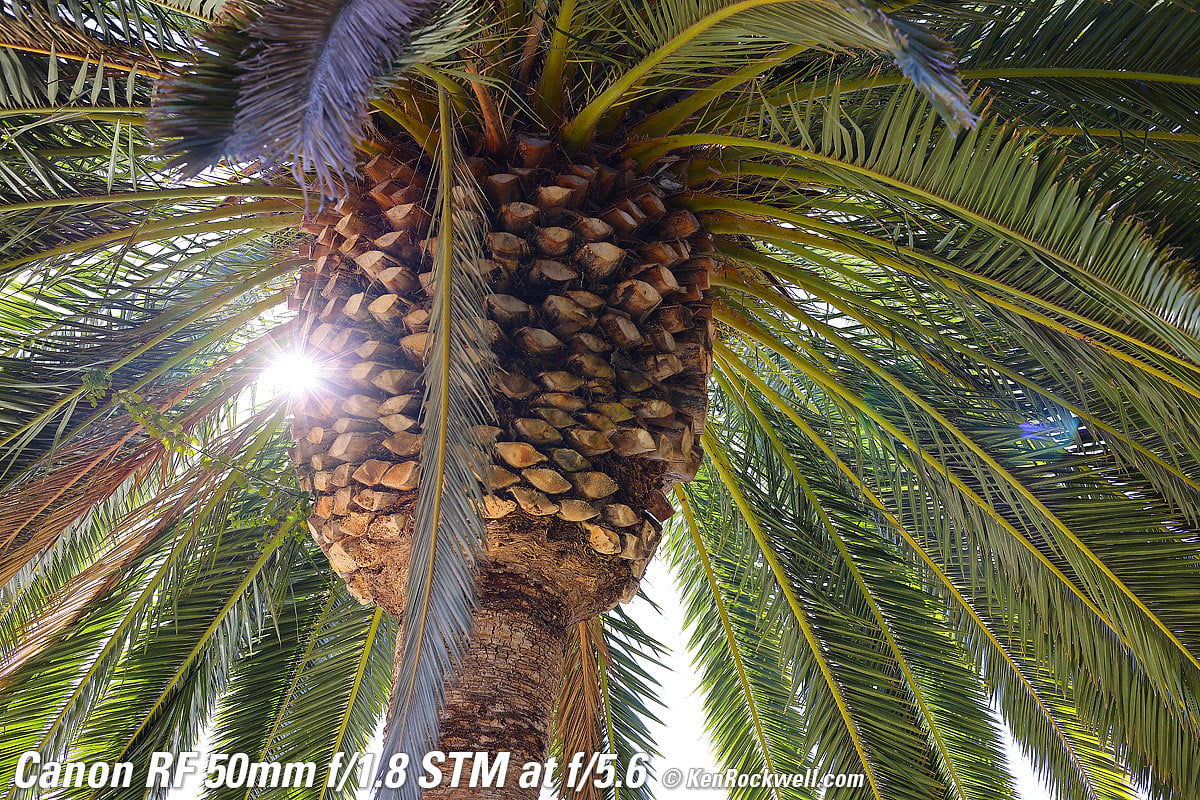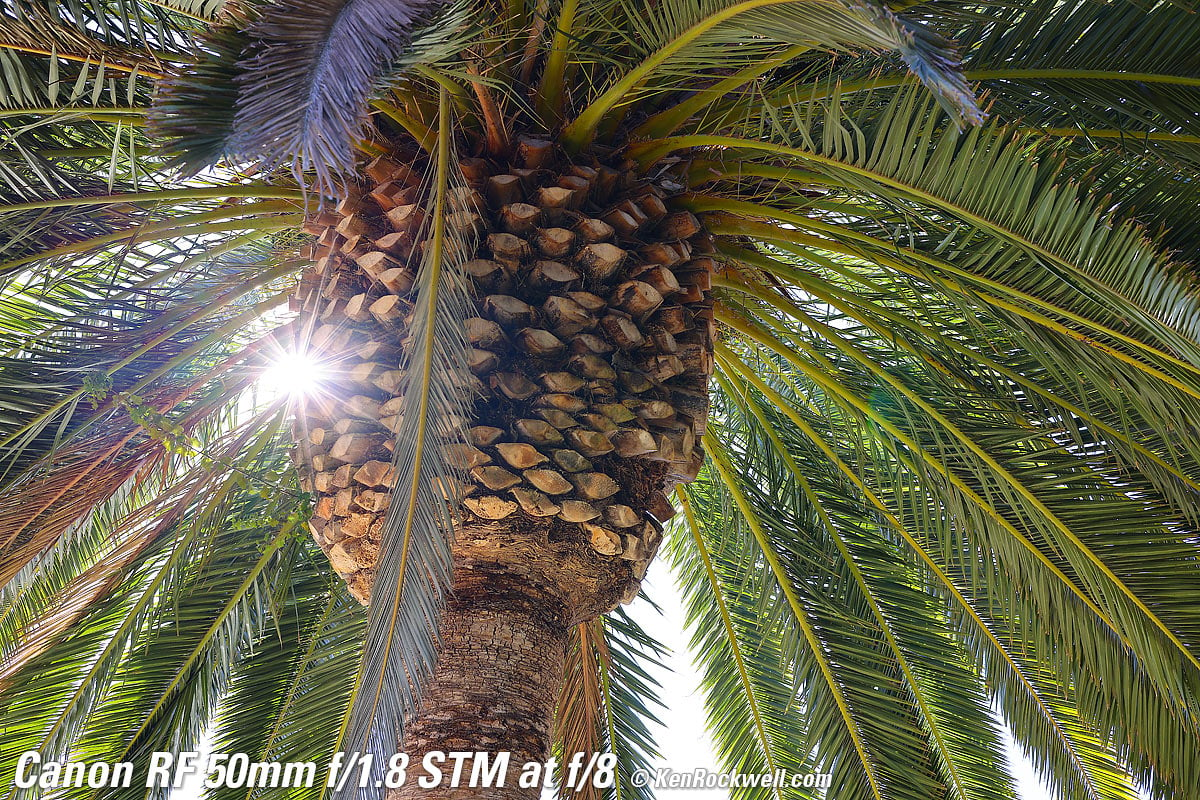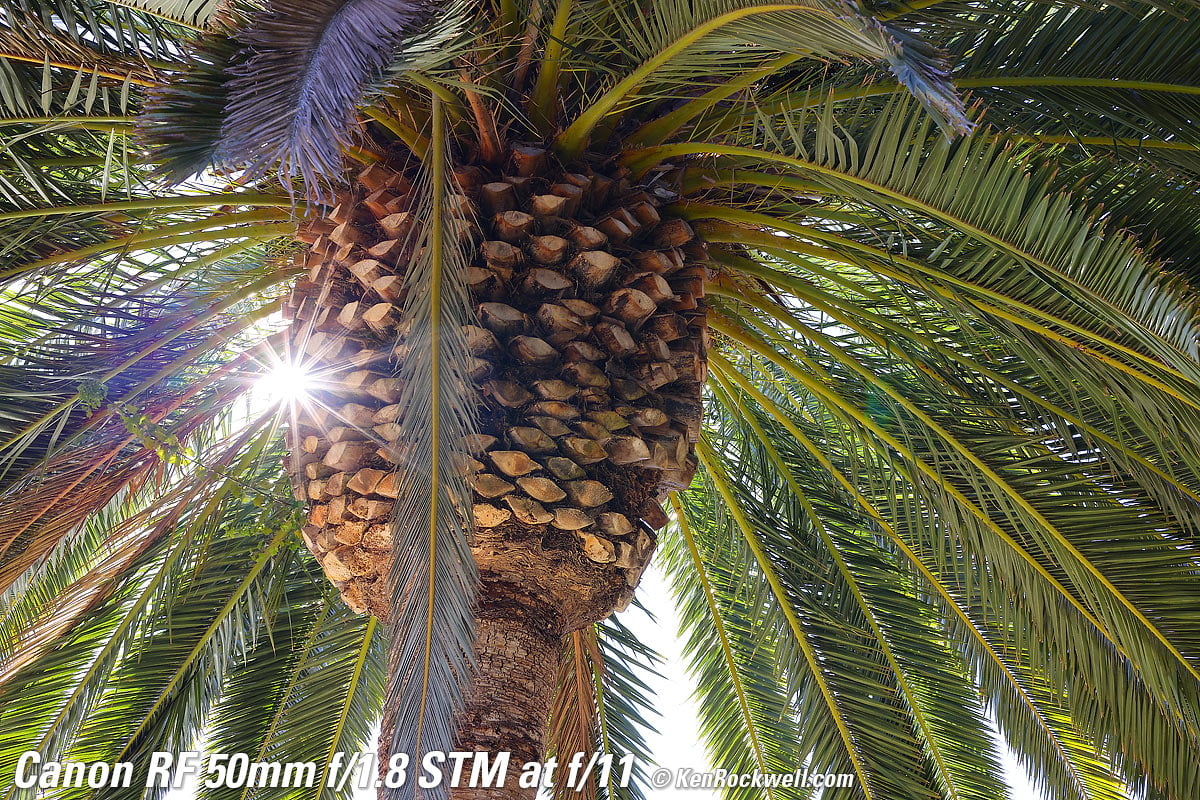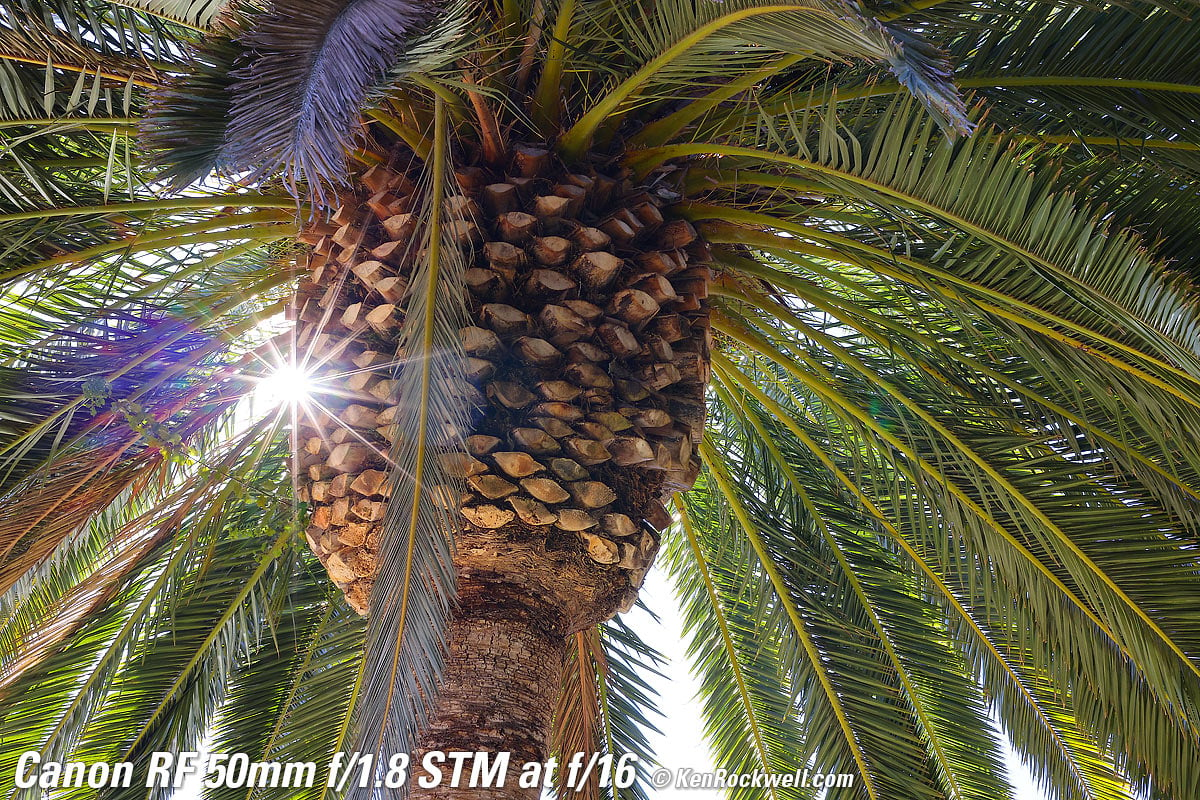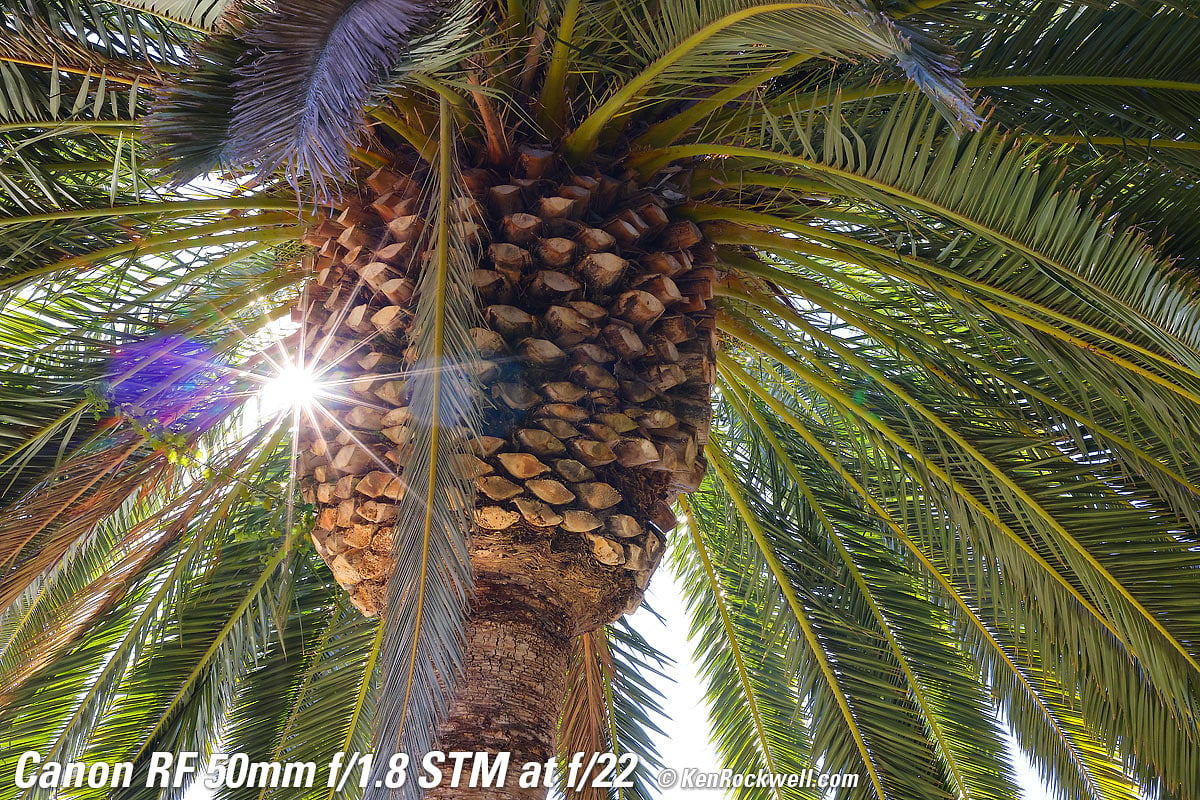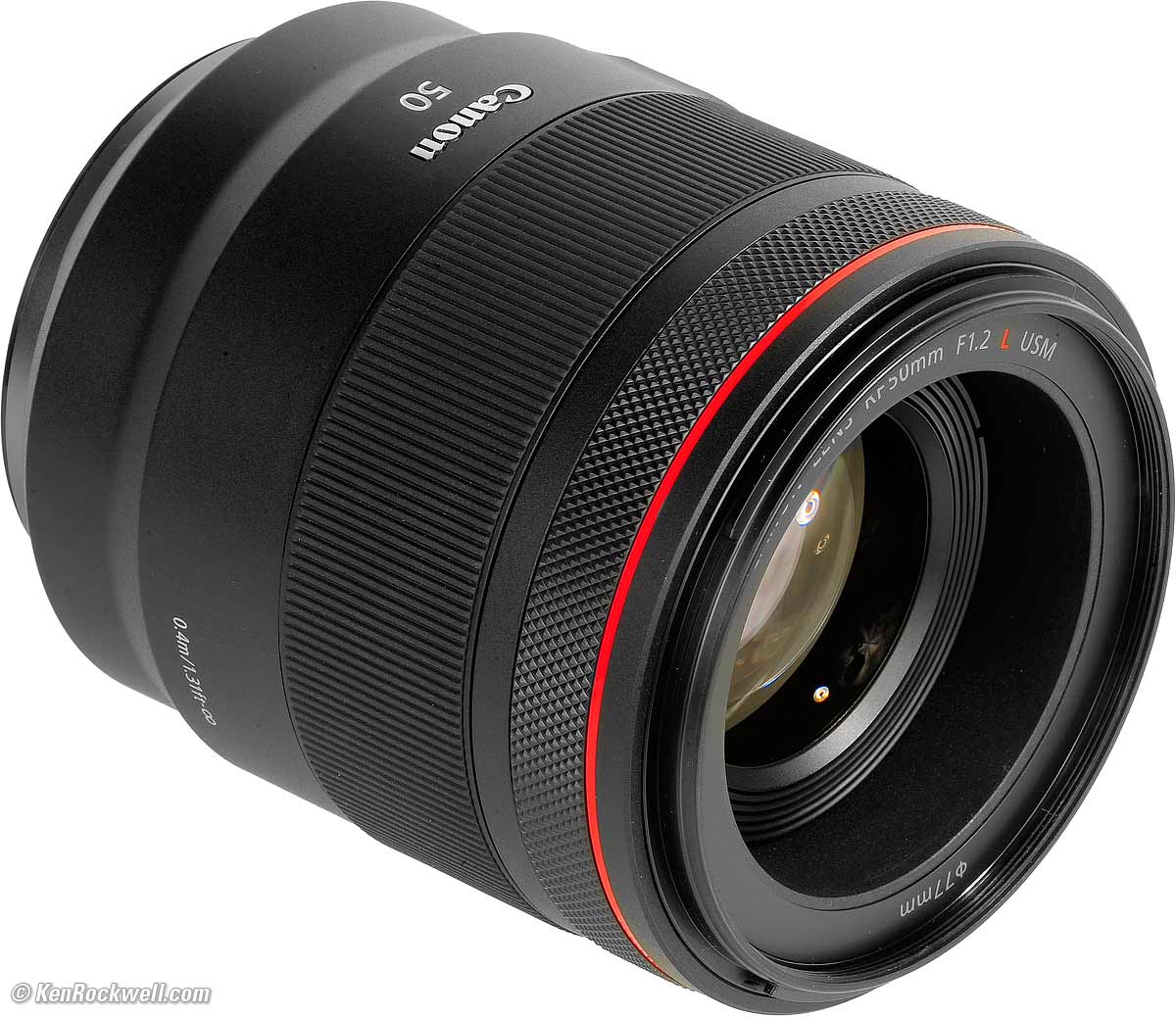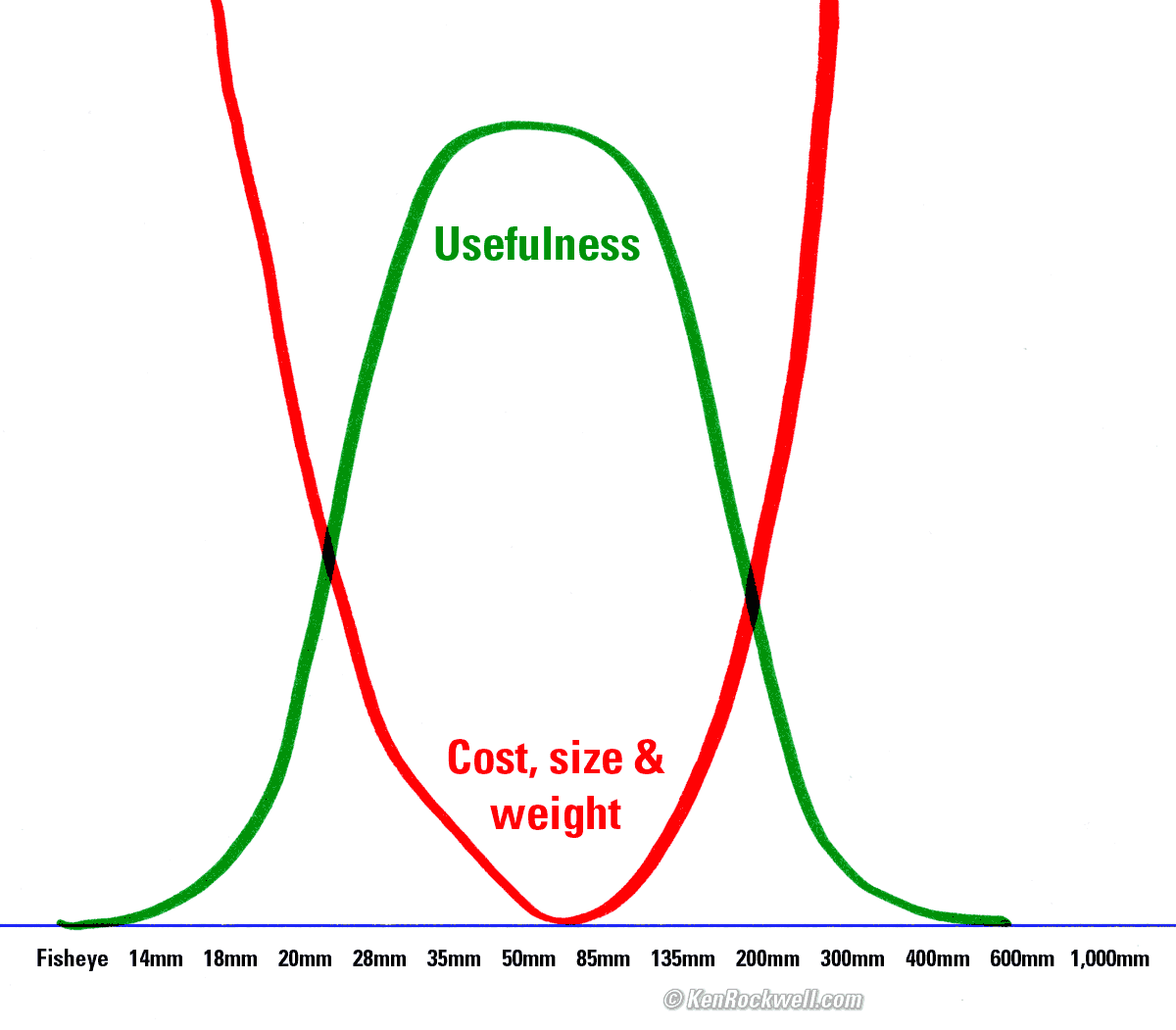Canon RF 50mm f/1.8
Full Frame Mirrorless STM
World's Closest-Focussing Non-Macro 50mm Lens (1'/0.3m)
Sample Images Introduction Compatibility
Specifications Accessories USA Version
Performance Compared User's Guide
R3 R5 R5C R6 II R6 R R8 RP R7 R10 R50 R100
Bodies Compared RF Lenses EF Lenses Flash
Canon RF 50mm f/1.8 STM (43mm filters, 5.6 oz./159g, 1'/0.3m close focus, $179 new or about $99 used). bigger. I got mine at B&H. I'd also get it at Adorama, at Amazon or at Crutchfield or used at eBay if you know How to Win at eBay.
This 100% all-content, junk-free website's biggest source of support is when you use those or any of these links to my personally approved sources I've used myself for way over 100 combined years when you get anything, regardless of the country in which you live. Canon does not seal its boxes in any way, so never buy at retail or any other source not on my personally approved list since you'll have no way of knowing if you're missing accessories, getting a defective, damaged, returned, non-USA, store demo or used lens — and all of my personally approved sources allow for 100% cash-back returns for at least 30 days if you don't love your new lens. I've used many of these sources since the 1970s because I can try it in my own hands and return it if I don't love it, and because they ship from secure remote warehouses where no one gets to touch your new lens before you do. Buy only from the approved sources I've used myself for decades for the best prices, service, return policies and selection.
July 2022 Better Pictures Canon Reviews Mirrorless RF Lenses EF Lenses Flash All Reviews
Sony vs. Nikon vs. Canon Full-Frame
Why Fixed Lenses Take Better Pictures
Canon EF 50mm f/1.8 STM review (for DSLRs)
Sample Images top
Sample Images Introduction Compatibility
Specifications Accessories USA Version
Performance Compared User's Guide
More samples at Bokeh, Macro, Spherochromatism and Sunstars.
These are just snapshots; my real work is in my Gallery.
These are all shot as NORMAL JPGs; no tripods, FINE JPGs or RAW CR3 files were used or needed.
Azure Wave, WindanSea Beach, California, 5:17 PM, 11 February 2021. Canon EOS R5, Canon RF 50mm f/1.8, f/11 at 1/6 at ISO 100 (LV 9.6), Perfectly Clear. bigger or camera-original © JPG file.
Fine Home, California, 5:48 PM, 11 February 2021. Canon EOS R5, Canon RF 50mm f/1.8, f/8 for 10 seconds at ISO 100 (LV 2.6), Perfectly Clear, perspective correction in Photoshop CS6. bigger, full resolution or camera-original © JPG file.
2021 Ferrari F8 Tributo, "A Celebration of Excellence," 10:05 AM, 13 February 2021. Canon EOS R5, Canon RF 50mm f/1.8, Canon 320EX flash, f/7.1 at 1/80 at Auto ISO 100, -1.3 stops exposure compensation, (LV 12), Perfectly Clear. bigger, full resolution or camera-original © JPG file.
Porsche 911 Carrera, 10:07 AM, 13 February 2021. Canon EOS R5, Canon RF 50mm f/1.8, f/5 at 1/200 at Auto ISO 100 (LV 12¼), Perfectly Clear. bigger or camera-original © JPG file.
Introduction top
Sample Images Introduction Compatibility
Specifications Accessories USA Version
Performance Compared User's Guide
|
I buy only from these approved sources. I can't vouch for ads below. |
This new mirrorless RF 50/1.8 STM is Canon's least expensive mirrorless RF lens, and possibly the sharpest. It is a superb lens in spite of its giveaway price, and it does this by refining one of photography's greatest classic lens designs.
This mirrorless RF 50/1.8 STM is quite different from 2015's DSLR EF 50mm f/1.8 STM. While they are both inexpensive and look and sound about the same by themselves, the optics of this new lens are more compact and sit much closer to the image sensor.
This difference becomes obvious when you put the older EF 50mm f/1.8 STM on an EF to RF adapter to use it on a mirrorless camera. This new lens is on the left, with the adapted combo on the right:
Canon RF 50mm f/1.8 STM and EF 50mm f/1.8 STM on EF to RF adapter. bigger.
Not only are this new lens' optics closer to the sensor so the whole thing becomes much smaller, it is Canon's first optical redesign of its classic 50mm f/1.8 since the first EF version of 1987, the 50mm f/1.8 II of 1990 and the EF 50mm f/1.8 STM of 2015, all of which use the same excellent 1987 design.
While this new RF lens still uses 6 elements in 5 groups for super-high contrast, one of these elements is now aspherical for the first time ever in any Canon 50mm lens slower than f/1.2. I'll explain the design history at Optics.
All Canon 50mm f/1.8 lenses have had superb optics, and now this new lens goes even further. Don't let the price fool you; 50mm f/1.8 lenses have always been top performers because their design is much easier and more developed than zooms, wide or tele or faster lenses. Moderate-speed normal lenses are a cinch to make super-sharp, and have all been superb for 50 years.
In actual use this Canon lens is as sharp as the Nikon Z 50mm f/1.8, but the foolish Nikon Z lens is 2½ times as heavy, over twice as long and three times as expensive! Is there any wonder why Nikon has fallen from number one in the 1980s to number three today?
I got my RF 50/1.8 STM at B&H. I'd also get it at Adorama, at Amazon or at Crutchfield or eventually used at eBay if you know How to Win at eBay.
Canon RF 50mm f/1.8. bigger.
New intro top
 First optical redesign of the Canon 50mm f/1.8 since 1987.
First optical redesign of the Canon 50mm f/1.8 since 1987.
 World's closest-focussing non-macro 50mm lens.
World's closest-focussing non-macro 50mm lens.
 None of the barrel distortion of the earlier designs.
None of the barrel distortion of the earlier designs.
 First 50mm f/1.8 from Canon with an aspherical element.
First 50mm f/1.8 from Canon with an aspherical element.
Good intro top
 Superb optics:
Superb optics:
 Very close focussing.
Very close focussing.
 Super sharp.
Super sharp.
 No distortion.
No distortion.
 Great sunstars.
Great sunstars.
 Super small.
Super small.
 Weightless.
Weightless.
 Inexpensive.
Inexpensive.
 100% U.S.A.-based high-quality technical support at (800) OK-CANON.
100% U.S.A.-based high-quality technical support at (800) OK-CANON.
Bad intro top
 No AF/MF switch.
No AF/MF switch.
 No stabilization switch.
No stabilization switch.
Missing intro top
 No Image Stabilization — but works with in-camera stabilization.
No Image Stabilization — but works with in-camera stabilization.
 No switch for in-camera Image Stabilization. In the R5 and R6 you have to find this in the menu system at MENU > CAMERA 7 > IS (Image Stabilizer). I put this in my MY MENU menu, and I'd prefer there being a switch on the lens.
No switch for in-camera Image Stabilization. In the R5 and R6 you have to find this in the menu system at MENU > CAMERA 7 > IS (Image Stabilizer). I put this in my MY MENU menu, and I'd prefer there being a switch on the lens.
 No AF/MF switch. Instead, you have to change this in a menu. I assign this to my MY MENU menu.
No AF/MF switch. Instead, you have to change this in a menu. I assign this to my MY MENU menu.
 No hood included. You don't need it, but you can get the ES-65B plastic bayonet hood separately.
No hood included. You don't need it, but you can get the ES-65B plastic bayonet hood separately.
 No case included. So?
No case included. So?
 No distortion.
No distortion.
 No high price.
No high price.
 No problems!
No problems!
Compatibility top
Sample Images Introduction Compatibility
Specifications Accessories USA Version
Performance Compared User's Guide
I got my RF 50/1.8 STM at B&H. I'd also get it at Adorama, at Amazon or at Crutchfield or eventually used at eBay if you know How to Win at eBay.
This lens only works on Canon's EOS-R series of mirrorless cameras.
It won't work with any teleconverters.
It won't fit on, and cannot be adapted to, any DSLR because a DSLR has too much distance between its sensor and its lens mount flange.
Specifications top
Sample Images Introduction Compatibility
Specifications Accessories USA Version
Performance Compared User's Guide
I got my RF 50/1.8 STM at B&H. I'd also get it at Adorama, at Amazon or at Crutchfield or eventually used at eBay if you know How to Win at eBay.
Name specifications top
Canon calls this the Canon RF 50mm f/1.8 STM:
RF: Works only on Canon's EOS-R Mirrorless cameras.
STM: STepper (autofocus) Motor.
Optics specifications top
Canon RF 50/1.8 internal optical construction. Glass and Aspherical elements.
6 elements in 5 groups.
1 Aspherical element.
Multicoated.
This is an updated double-Gauss design.
In 1817 mathematician Carl Gauss invented a way to improve the performance of single-element telescope objective by adding a second slightly negative element made of a different kind of glass. These two lens elements together made a much better telescope objective, the Gauss Objective or "Gauss Lens."
In 1888 Bausch and Lomb realized putting two reversed sets of these together (4 symmetrical elements total) would cancel-out many aberrations across a large field for photographic use. In 1896 Dr. Paul Rudolph of Zeiss split each of these two inner elements (negative elements 2 and 3) into two cemented elements each to create the 6-element, 4-group ZEISS PLANAR lens on which almost all medium focal length camera lenses have been based ever since.
This lens is also based on the 1896 PLANAR, splitting the fourth and fifth elements and making the fifth element aspherical.
Thus this lens' supreme optical performance comes from over 200 years continuous advancement.
Diaphragm specifications
Canon RF 50mm f/1.8. bigger.
7 rounded blades.
Electronically actuated.
Stops down to f/22.
Filters specifications top
Plastic 43mm filter thread.
Angle of View specifications top
46º diagonal.
40º horizontal.
27.5º vertical.
Focus Scale specifications top
No.
Not on lens, but can be displayed in-camera.
Infinity Focus Stop specifications top
No.
Depth of Field Scale specifications top
No.
Not on lens, but may be displayed in-camera.
Infrared Focus Index specifications top
No.
Close Focus specifications top
1 foot (0.3 meters).
Maximum Reproduction Ratio specifications top
1:4 (0.25 ×).
Reproduction Ratio Scale specifications top
No.
Image Stabilizer specifications top
None, but will work with in-camera stabilization
Caps specifications top
Canon 43mm Front Cap (p/n 6317B001) and
Rear Lens Dust Cap RF (p/n 2962C001), both included.
Hood specifications top
Optional ES-65B plastic bayonet hood.
Case specifications top
None.
Size specifications top
2.72" ø maximum diameter × 1.59" extension from flange.
69.2 mm ø maximum diameter × 40.5 mm extension from flange.
Weight specifications top
5.620 oz. (159.25 g) actual measured weight.
Rated 5.64 oz. (160 g).
Quality specifications top
Made in Malaysia.
Announced specifications top
Thursday, 05 November 2020.
Included specifications top
Canon 43mm Front Cap (p/n 6317B001).
Rear Lens Dust Cap RF (p/n 2962C001).
Canon's Model Numbers specifications top
RF5018STM.
4515C002 (4515C001 in Japan).
JAN 4549292-181623.
Price, U. S. A. specifications top
July 2022
$179 at B&H, at Adorama, at Amazon or at Crutchfield.
About $99 used if you know How to Win at eBay.
February 2021
$199.
Canon RF 50mm f/1.8. bigger.
Optional Accessories top
Sample Images Introduction Compatibility
Specifications Accessories USA Version
Performance Compared User's Guide
I got my RF 50/1.8 STM at B&H. I'd also get it at Adorama, at Amazon or at Crutchfield or eventually used at eBay if you know How to Win at eBay.
ES-65B plastic bayonet hood.
Getting a Legal U. S. A. Version top
Sample Images Introduction Compatibility
Specifications Accessories USA Version
Performance Compared User's Guide
I got my RF 50/1.8 STM at B&H. I'd also get it at Adorama, at Amazon or at Crutchfield or eventually used at eBay if you know How to Win at eBay.
Canon RF 50mm f/1.8 U. S. A. Warranty Card. bigger.
Your lens must include a printed U. S. A. warranty card like the one shown above from Canon U.S.A., Inc. It should be on top inside your box as you open it. The serial number on the card must match the nearly invisible serial number engraved in black-on-black on the bottom of your lens barrel, between the molded certification logos and the function ring.
If not, you got ripped off with a gray market version from another country. This is why I never buy anyplace other than from my personally approved sources. You just can't take the chance of buying elsewhere, especially at any retail store, because non-U. S. A. versions have no warranty in the U. S. A., and you probably won't be able to get firmware or service for it — even if you're willing to pay out-of-pocket for it when you need it!
Shifty dealers may include color copies of a card from a legitimate U. S. A. lens in a gray-market box, hoping you won't check serial numbers and catch their fraud. A card with the wrong serial number means nothing other than that you have no warranty coverage.
The serial number on the box doesn't have to match, but it should. It will be hidden someplace on the sticker with all the bar codes. If not, it means a shady dealer took things out of boxes and was too sloppy to put them back correctly — and it means you got a used lens if anyone other than you took it out of the box.
If a gray market version saves you $100 the risk might be worth it, but for $50 or less I wouldn't risk having no warranty or support.
Always be sure to check yours while you can still return it, or just don't buy from unapproved sources or at retail so you'll be able to have your camera serviced and get free updated firmware as needed. Get yours from the same places I do and you won't have a problem.
Performance top
Sample Images Introduction Compatibility
Specifications Accessories USA Version
Performance Compared User's Guide
Overall Autofocus Manual Focus Breathing Bokeh
Distortion Ergonomics Falloff Filters Flare & Ghosts
Lateral Color Fringes Lens Corrections Macro
Mechanics Sharpness Spherochromatism
Stabilization Sunstars Teleconverters Data
I got my RF 50/1.8 STM at B&H. I'd also get it at Adorama, at Amazon or at Crutchfield or eventually used at eBay if you know How to Win at eBay.
Overall performance top
The Canon RF 50/1.8 STM is an extraordinary lens, at an even more extraordinarily low price.
Autofocus performance top
Autofocus is reasonably fast.
It uses a stepper motor to hum in and out.
Manual Focus performance top
Manual focusing is entirely electronic; the manual focus ring isn't connected to anything other than a digital encoder.
How to get instant manual-focus override.
Focus Breathing performance top
Focus breathing is the image changing size as focused in and out. It's important to cinematographers that the image not breathe because it looks funny if the image changes size as focus gets pulled back and forth between actors. If the lens does this, the image "breathes" by growing and contracting slightly as the dialog goes back and forth.
As a unit-focus lens, the image grows as focussed more closely.
Bokeh performance top
Bokeh, the feel, character or quality of out-of-focus areas as opposed to how far out of focus they are, is fair. Background points of light become somewhat weird blobs. This is typical for aspherical lenses. Bokeh looks great at macro distances.
Here's a shot from headshot distance wide-open. I'm focused on the DAVIS logo. Click it for the camera-original © image file:
Made-in-U. S. A. Davis 6250 weather station, 18 February 2021. Canon EOS R5, Canon RF 50mm f/1.8 at f/1.8 at 1/8,000 at ISO 100 (LV 14.6), Perfectly Clear. bigger or camera-original © JPG file.
As always, if you want to throw the background as far out of focus as possible, shoot at f/1.8 and get as close as possible.
Distortion performance top
The Canon RF 50mm f/1.8 STM has no visible distortion.
For more critical scientific use, use a factor of +0.20 in Photoshop's lens correction filter. You can't possibly see this tiny level of distortion with your eyes unless you deliberately look at an image at 500% and compare it against a ruler in Photoshop.
On my R5 it has the same vanishingly low level of distortion regardless of whether or not my R5's Distortion Correction is ON or OFF, so I leave it at its default of OFF.
These aren't facts or specifications, they are the results of my research that requires hours of photography and calculations on the resulting data.
Ergonomics performance top
Canon RF 50mm f/1.8. bigger. |
Canon RF 50mm f/1.8. bigger. |
It's a little lens with one ring and one switch, what could go wrong?
I'd prefer that the switch be AF/MF; if you look closely you'll see that it's a FOCUS/CONTROL switch, explained in my Users's Guide.
Falloff performance top
Falloff is invisible with the a camera left at its default of MENU > CAMERA > Lens aberration correction > Peripheral illum corr > ON.
I've greatly exaggerated the falloff by shooting a gray field and placing these on a gray background; it will not look this bad in actual photos of real things:
Canon RF 50/1.8 STM falloff on full-frame at infinity, correction at default of ON.
© 2021 KenRockwell.com. All rights reserved. |
If you go out of your way to disable the automatic correction by setting MENU > CAMERA > Lens aberration correction > Peripheral illum corr > OFF, you will see some falloff wide-open at f/1.8 and f/2, but that's about it.
I've greatly exaggerated the falloff by shooting a gray field and placing these on a gray background; it will not look this bad in actual photos of real things:
Canon RF 50/1.8 STM falloff on full-frame at infinity, correction deliberately turned OFF.
© 2021 KenRockwell.com. All rights reserved. |
Filters, use with performance top
There's no need for thin filters. I can stack a few 43mm filters (what kind of nut has more than one of these? I do!) with no vignetting.
Go ahead and use your standard rotating polarizer and grad filters - in 43mm size.
If you're a filter aficionado your best bet is to use a 43mm to 52mm adapter ring (or to whatever size is most of your filter collection) rather than to buy a new set in 43mm.
Flare & Ghosts performance top
There are some classic-looking ghosts if you really push it, but nothing out of the ordinary.
See exaggerated examples at Sunstars.
Lateral Color Fringes performance top
There are no lateral color fringes when shot as JPG with the default Chromatic Aberration Correction left ON.
if you go out of your way to turn this OFF (or shoot raw and then use non-manufacturer software to process that data into images) then there is nothing visible, unless you go in a laboratory and really, really look for it, in which case there is an almost invisible amount of green-magenta lateral color. Even at 45MP you'll probably never not see it with correction left off (or shooting raw and using random software to read your data).
Leave correction at its default of ON and it's not there.
There is spherochromatism, which can cause color fringes on things that aren't in perfect focus. Spherochromatism is a completely different aberration in a different dimension than lateral color fringes.
Lens Corrections performance top
Other cameras may vary, but my EOS R5, EOS R6 and EOS RP all have options to correct for falloff (Peripheral Illumination Correction), Distortion and a Digital Lens Optimizer which correct for a suite of other aberrations. The EOS R has this, too; I just don't have one handy to check the specifics with this lens.
Falloff correction and the Digital Lens Optimizer are ON by default.
This lens has no visible distortion, so Distortion correction is OFF by default. There's no change in distortion with it ON, at least in my R5.
If you turn off the Digital Lens Optimizer, you are then offered à la carte ON/OFF options for Chromatic Aberration Correction and Diffraction Correction — at least on my EOS R5, EOS R6 and EOS RP.
Macro Performance performance top
Macro gets pretty close; closer than any other non-macro 50mm lens. Bravo!
At f/1.8
It's sharp at f/1.8, but limited depth of field, spherical aberration and spherochromatism mean that you're really asking for trouble if you want ultrasharp images this close at f/1.8. Depth-of-field at f/1.8 with any lens is measured in hundredths of a millimeter this close, so good luck:
Casio G-Shock Solar Atomic Watch at close-focus distance, 18 February 2021. Canon EOS R5, Canon RF 50mm f/1.8 at f/1.8 at 1/3,200 at ISO 50 (LV 14¼). bigger or camera-original © file.
1,200 × 900 pixel (6.8× magnification) crop from above. bigger or camera-original © file.
If this 1,200 × 900 pixel crop is about 3" (7.5cm) wide on your screen, the complete image would print at a large 14 × 21″ (35 × 55 cm) at this same high magnification.
If this 1,200 × 900 pixel crop is about 6" (15cm) wide on your screen, the complete image would print at a huge 27½ × 41¼″ (70 × 105 cm) at this same high magnification.
If this 1,200 × 900 pixel crop is about 12" (30cm) wide on your screen, the complete image would print at a mammoth 55 × 82½″ (1.4 × 2.1 meters) at this same extremely high magnification!
At f/8
Stop it down, and it's fantastic. Unless you're copying flat documents, I usually shoot around f/16 of f/22 this close to get as much as I can in focus.
Casio G-Shock Solar Atomic Watch at close-focus distance, 18 February 2021. Canon EOS R5, Canon RF 50mm f/1.8 at f/8 at 1/160 at ISO 50 (LV 14.4). bigger or camera-original © file.
1,200 × 900 pixel (6.8× magnification) crop from above. bigger or camera-original © file.
If this 1,200 × 900 pixel crop is about 3" (7.5cm) wide on your screen, the complete image would print at a large 14 × 21″ (35 × 55 cm) at this same high magnification.
If this 1,200 × 900 pixel crop is about 6" (15cm) wide on your screen, the complete image would print at a huge 27½ × 41¼″ (70 × 105 cm) at this same high magnification.
If this 1,200 × 900 pixel crop is about 12" (30cm) wide on your screen, the complete image would print at a mammoth 55 × 82½″ (1.4 × 2.1 meters) at this same extremely high magnification!
Mechanical Quality performance top
Canon RF 50mm f/1.8. bigger.
Like many lenses today, it's all plastic except for the mount.
Finish
Semi-matte black plastic.
Front Bumper
None.
Filter Threads
Plastic.
Hood Bayonet Mount
Plastic.
Exterior
All plastic.
Focus Ring
Knurled-style molded plastic.
Slide Switch
Plastic.
Identity
Printed around front of lens, also printed "50" on top of barrel.
Internals
Seem like all plastic, and even the diaphragm blades sort of look like plastic. Hmm.
Dust Gasket at Mount
No.
Mount
Chromed metal.
It seems like brass, which is a huge step up from some really crummy lenses from Nikon and Sony which went to aluminum, which is better than plastic for breakage, but not much better for wear.
Markings
Paint.
Serial Number
Almost invisibly laser engraved in black-on-black on the bottom of the barrel, between the molded certification logos and the focus/control ring.
Date Code
None found.
Noises When Shaken
Mild to moderate clattering.
Made in
Made in Malaysia.
Sharpness performance top
Lens sharpness has nothing to do with picture sharpness; every lens made in the past 100 years is more than sharp enough to make super-sharp pictures if you know what you're doing. The only limitation to picture sharpness is your skill as a photographer. It's the least talented who spend the most time worrying about lens sharpness and blame crummy pictures on their equipment rather than themselves. Skilled photographers make great images with whatever camera is in their hands; I've made some of my best images of all time with an irreparably broken camera! Most pixels are thrown away before you see them, but camera makers don't want you to know that.
If you're not getting ultra-sharp pictures with this, be sure not to shoot at f/11 or smaller where all lenses are softer due to diffraction, always shoot at ISO 100 or below because cameras become softer at ISO 200 and above, be sure everything is in perfect focus, set your camera's sharpening as you want it (I usually set mine to the maximums at MENU > CAMERA > Picture Style > INFO > Sharpness) and be sure nothing is moving, either camera or subject. If you want to ensure a soft image with any lens, shoot at f/16 or smaller at ISO 1,600 or above at default sharpening in daylight of subjects at differing distances in the same image.
These caveats aside, as I've been saying since the first paragraph, this lens is just about perfect. The worst thing I can see on my 45MP R5, if I'm crazy enough to do something stupid like shoot wide-open at f/1.8 (where lens aberrations are most obvious) and shoot something where the far edges are also in perfect focus (which almost never happens in good photos), and then, and only then in the far corners, there might be just a little bit of minor smearing, which is what the diverging sagittal and meridional lines in the MTF curve suggest.
If you can't make a sharp picture with this lens, it's not the lens. Be careful with focus modes; if you can't get sharp images in daylight at f/1.8, be sure you're actually getting perfect focus. The EOS-R cameras often stop-down as they focus (manually or AF) in daylight, and that may or may not give you the most accurate focus for shooting at f/1.8 in bright light.
Canon RF 50mm f/1.8 MTF wide-open at 10 cyc/mm (black) and 30 cyc/mm (blue). Sagittal (solid) and meridional (dashed).
Spherochromatism performance top
Spherochromatism, also called secondary spherical chromatic aberration or "color bokeh," is an advanced form of spherical and chromatic aberration in a different dimension than lateral chromatic aberration. It happens mostly in fast normal and tele lenses when spherical aberration at the ends of the color spectrum are corrected differently than in the middle of the spectrum. Spherochromatism can cause colored fringes on out-of-focus highlights, usually seen as green fringes on backgrounds and magenta fringes on foregrounds. Spherochromatism is common in fast lenses of moderate focal length when shooting contrasty items at full aperture. It goes away as stopped down.
It has a typical amount of spherochromatism:
Mondaine A132.30348.11SBB at close-focus distance, 18 February 2021. Canon EOS R5, Canon RF 50mm f/1.8 at f/1.8 at 1/6,400 at ISO 50 (LV 15¼). bigger or camera-original © file.
1,200 × 900 pixel (6.8× magnification) crop from above. bigger or camera-original © file.
If this 1,200 × 900 pixel crop is about 3" (7.5cm) wide on your screen, the complete image would print at a large 14 × 21″ (35 × 55 cm) at this same high magnification.
If this 1,200 × 900 pixel crop is about 6" (15cm) wide on your screen, the complete image would print at a huge 27½ × 41¼″ (70 × 105 cm) at this same high magnification.
If this 1,200 × 900 pixel crop is about 12" (30cm) wide on your screen, the complete image would print at a mammoth 55 × 82½″ (1.4 × 2.1 meters) at this same extremely high magnification!
Image Stabilization performance top
This lens has no Optical Image Stabilization (OIS, IS or VR (Vibration Reduction)), but it will work with in-camera stabilization.
"Percent Perfectly Sharp Shots" are the percentage of frames with 100% perfect tripod-equivalent sharpness I get when I'm shooting hand-held while free-standing with no support or bracing. Hand tremor is a random occurrence, so at marginal speeds some frames will be perfectly sharp while others will be in various stages of blur — all at the same shutter speed. This rates what percentage of shots are perfectly sharp, not how sharp are all the frames:
| % Perfectly Sharp Shots on 45MP R5 | 1 |
1/2 |
1/4 |
1/8 |
1/15 |
1/30 |
1/60 |
1/125 |
1/250 |
| Stabilization ON | 0 |
0 |
17 |
40 |
50 |
100 |
100 |
100 |
100 |
| Stabilization OFF | 0 |
0 |
0 |
0 |
10 |
50 |
100 |
100 |
100 |
I only get about a stop to a stop-and-a-half of real-world improvement with my R5's built-in stabilization, which isn't much.
Heck, even my 1956 ZEISS SONNAR 50mm f/1.5 using a CONTAX to LEICA M adapter and then a LEICA M to EOS R adapter is a stop better with in-camera stabilization, but you didn't ask me that.
In-camera stabilization rarely works as well as optical stabilization, but it's better than nothing.
Sunstars performance top
With a 7-bladed rounded diaphragm I get nice, sharp 14-pointed sunstars on brilliant points of light at moderate to small apertures.
Click any to enlarge:
Click any to enlarge.
Teleconverters performance top
Neither the RF 1.4× or 2× teleconverters will mount to this lens. Either one would have to poke too far into the rear of this lens, so they just won't fit.
In fact, no teleconverter will mount to this lens.
Data performance top
EXIF includes the lens name, "RF50mm F1.8 STM," the focal length, shooting aperture, and the focus distance.
Compared top
Sample Images Introduction Compatibility
Specifications Accessories USA Version
Performance Compared User's Guide
I got my RF 50/1.8 STM at B&H. I'd also get it at Adorama, at Amazon or at Crutchfield or eventually used at eBay if you know How to Win at eBay.
Versus the EF 50/1.8 STM on an EF to RF Adapter
Optics are excellent in both cases. Both are ultrasharp, while this RF version has no distortion and focuses closer than the older EF 50mm f/1.8 STM.
I get slightly more consistent autofocus at f/1.8 in daylight with my EF 50mm f/1.8 STM on my EF to RF adapter, but the combo is much larger:
Canon RF 50mm f/1.8 STM and EF 50mm f/1.8 STM on EF to RF adapter. bigger.
Versus the RF 50mm f/1.2L
The RF 50mm f/1.2L is, ahem, the world's greatest 50mm lens — but it doesn't take any better pictures. It's ultrasharp like the f/1.8, but big and expensive.
Here's a secret: the pictures are the same! Both the RF 50mm f/1.2L and this RF 50/1.8 STM are equally ultrasharp.
While I almost can see very slight differences in sharpness in the lab when shot at wider than f/2.8 in the very farthest corners, no one takes pictures like that. The RF 50mm f/1.2L is for astronomers and collectors who like expensive stuff. Once you've stopped down to f/2.8 and smaller, each are as sharp as the other.
For actual photography, not only is the RF 50mm f/1.2L almost three times longer, six times heavier and over eleven times as expensive, this little RF 50/1.8 STM focuses closer and has better sunstars — and is just as incredibly sharp. So there.
Consumers lacking Ph.D. degrees in optical design tend not to realize that modern lenses, and especially fixed 50mm lenses, are all just about 100% sharp, which is as sharp as you can get. They only get a little softer than 100% in the corners and only do that at maximum aperture, and great lenses like these don't get that much softer there anyway. Once stopped down to f/2.8 or smaller, they're all 100% sharp. The reason to pay $2,300 for the f/1.2L is for astronomy or just because you like nice stuff; the pictures are the same. Lenses don't get above 100% sharp (MTF); it's not like the f/1.2L has any ability to get above 100% MTF.
User's Guide top
Sample Images Introduction Compatibility
Specifications Accessories USA Version
Performance Compared User's Guide
I got my RF 50/1.8 STM at B&H. I'd also get it at Adorama, at Amazon or at Crutchfield or eventually used at eBay if you know How to Win at eBay.
Canon RF 50mm f/1.8. bigger.
FOCUS / CONTROL Switch user's guide top
FOCUS: The ring will focus manually if you are in MF mode, or if AF has locked in ONE SHOT and you keep the shutter half pressed with manual-focus override set.
CONTROL: This lets you reassign the ring's function to control other things, which you can program at MENU > CUSTOM SETTINGS > Customize Dials > Control Ring. Oddly, at least in my R5, FOCUS MODE (AF-MF) isn't among the options.
AF-MF Switch user's guide top
There is none. You have to set this in a menu. Poo.
In the R5 it's at MENU > AF 1 > Focus mode > AF or MF, or in the R6, at MENU > AF 2 > Focus mode > AF or MF.
I forget where it is in the EOS-R and RP, but it's in there someplace.
Manual-Focus user's guide top
Once the manual focus mode is set, you also have these options:
In-finder focus-distance scale
Select the in-finder focus-distance scale at MENU > CAMERA 7 > Shooting info. disp. > Focus distance disp., at least in the R5 and R6.
Focus Peaking
Focus peaking is enabled and set at MENU > AF 2 > MF peaking settings, at least in the R5 and R6.
Manual-Focus Override user's guide top
By default, there is no always-responsive instant manual-focus override as we take for granted in our DSLRs.
EOS R cameras need a menu setting changed for manual-focus override, otherwise the focus ring is always ignored in AF.
Find the "Lens electronic AF" option (MENU > AF 4 in EOS R5 and EOS R6 or MENU > CAMERA 8 in EOS RP), and set it to either "One‑Shot‑>enabled" or "One‑Shot‑>enabled (magnify)."
Canon should have it set this way by default, but they don't. No big deal now that I figured it out.
Now manual focus override works if you turn the ring while continuing to hold the shutter halfway, but only after focus locks in ONE SHOT.
STABILIZER Switch user's guide top
There is no switch to control in-camera stabilization in the R5 and R6.
Instead, set this, at least in the R5 and R6, at MENU > CAMERA 7 > IS (Image Stabilizer) > ON or OFF.
Setting it down user's guide top
Don't do this, but you can push and pull the inner optical tube in and out from the lens body with your fingers, exactly as the STM focus motor does. In other words, it's geared so fast that you can move the focus system in and out by force.
Because of this, if your camera is ON and awake and you place the camera face-down on a table with the weight of the camera supported by the front of the lens, the camera will keep trying to move the lens back out as its weight keeps trying to push it back in.
These are the weird electronic sounds you'll hear if you put an awake camera face-down on a table. Try not to do this.
Recommendations top
Sample Images Introduction Compatibility
Specifications Accessories USA Version
Performance Compared User's Guide
As if I haven't already said this, the RF 50mm f/1.8 STM is among the sharpest lenses you can get, as well as one of the most useful and least expensive. If you think you want one, get it. I got mine at B&H. I'd also get it at Adorama, at Amazon or at Crutchfield or eventually used at eBay if you know How to Win at eBay.
Lens Utility, Cost, Size & Weight versus Focal Length. bigger.
I use a clear (UV) protective filter instead of a cap so I'm always ready to shoot instantly. I only use a cap when I throw this in a bag with other gear without padding — which is never. The UV filter never gets in the way, and never gets lost, either.
The B+W 43mm 010 is an excellent filter, but it's not multicoated which could lead to more ghosts in harsh light. Try the multicoated B+W 101M or the Hoya 43mm Multicoated NXT filter if you shoot into the light. The Hoya NXT Plus filter adds a water-resistant coating. Fuji offers its own 43mm Protector filter.
All these filters are just as sharp and take the same pictures, the difference is how much abuse they'll take and stay clean and stay in one piece. Since filters last a lifetime or more, there's no reason not to buy the best as it will last you for the next 40 years. Filters aren't throwaways like digital cameras which we replace every few years, like it or not. I'm still using filters I bought back in the 1970s!
This 100% all-content, junk-free website's biggest source of support is when you use those or any of these links to my personally approved sources I've used myself for way over 100 combined years when you get anything, regardless of the country in which you live. Canon does not seal its boxes in any way, so never buy at retail or any other source not on my personally approved list since you'll have no way of knowing if you're missing accessories, getting a defective, damaged, returned, non-USA, store demo or used lens — and all of my personally approved sources allow for 100% cash-back returns for at least 30 days if you don't love your new lens. I've used many of these stores since the 1970s because I can try it in my own hands and return it if I don't love it, and because they ship from secure remote warehouses where no one gets to touch your new lens before you do. Buy only from the approved sources I've used myself for decades for the best prices, service, return policies and selection.
Thanks for helping me help you!
Ken.
© Ken Rockwell. All rights reserved. Tous droits réservés. Alle Rechte vorbehalten. Ken Rockwell® is a registered trademark.
Help Me Help You
I support my growing family through this website, as crazy as it might seem.
The biggest help is when you use any of these links when you get anything. It costs you nothing, and is this site's, and thus my family's, biggest source of support. These places always have the best prices and service, which is why I've used them since before this website existed. I recommend them all personally.
If you find this page as helpful as a book you might have had to buy or a workshop you may have had to take, feel free to help me continue helping everyone.
If you've gotten your gear through one of my links or helped otherwise, you're family. It's great people like you who allow me to keep adding to this site full-time. Thanks!
If you haven't helped yet, please do, and consider helping me with a gift of $5.00.
As this page is copyrighted and formally registered, it is unlawful to make copies, especially in the form of printouts for personal use. If you wish to make a printout for personal use, you are granted one-time permission only if you PayPal me $5.00 per printout or part thereof. Thank you!
Thanks for reading!
Ken.
